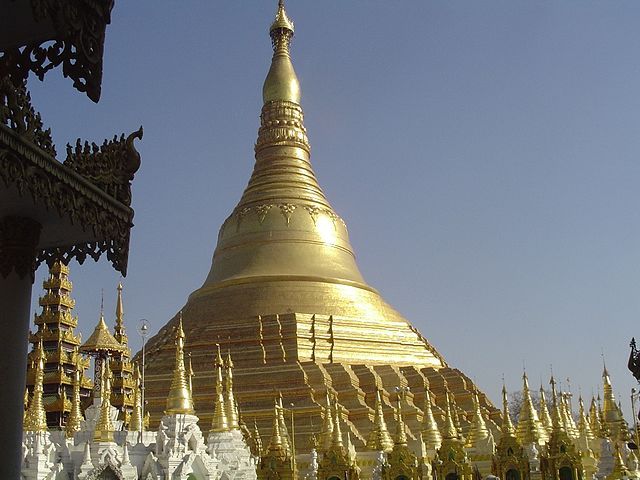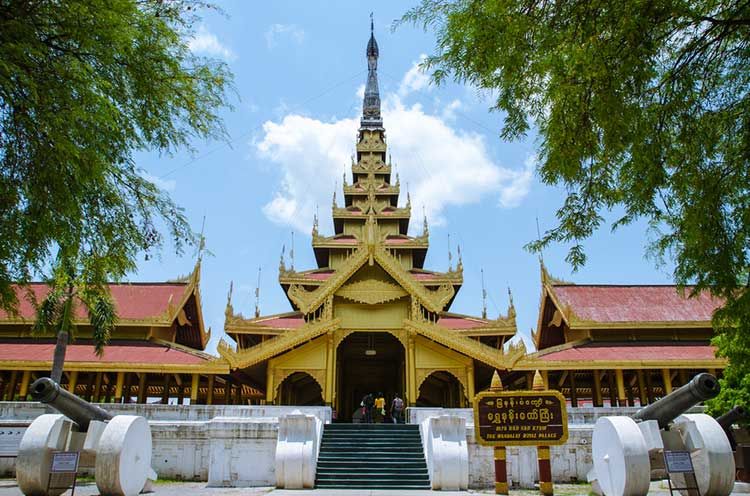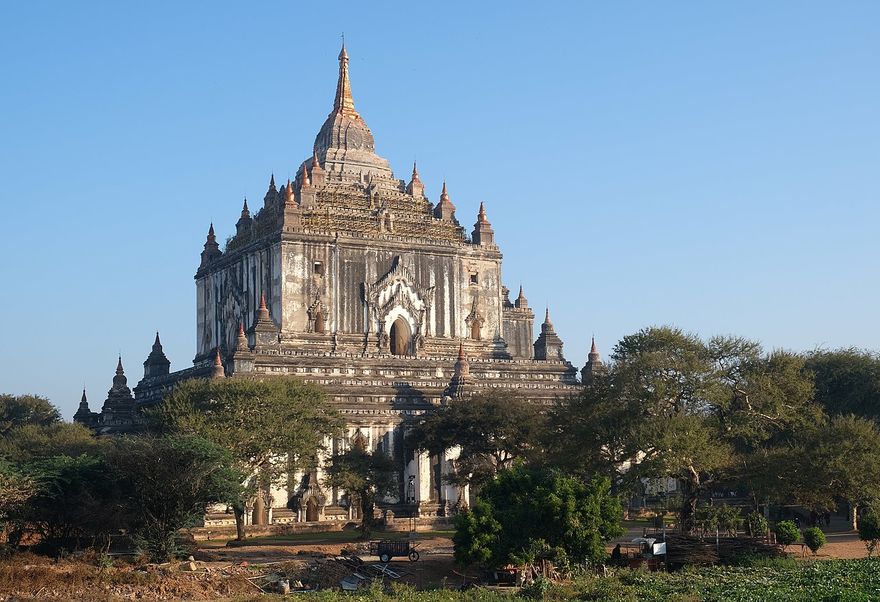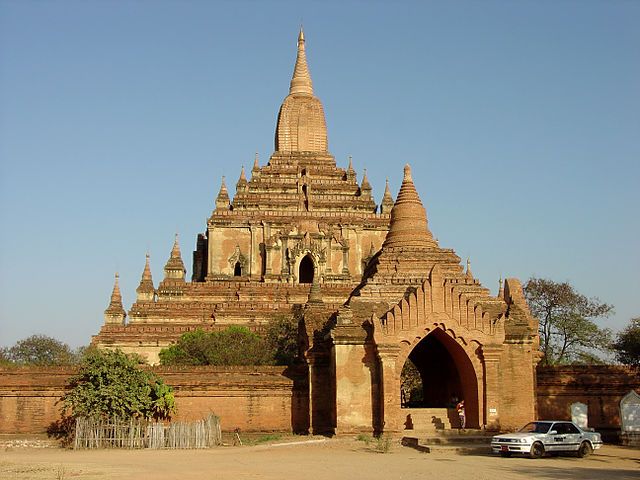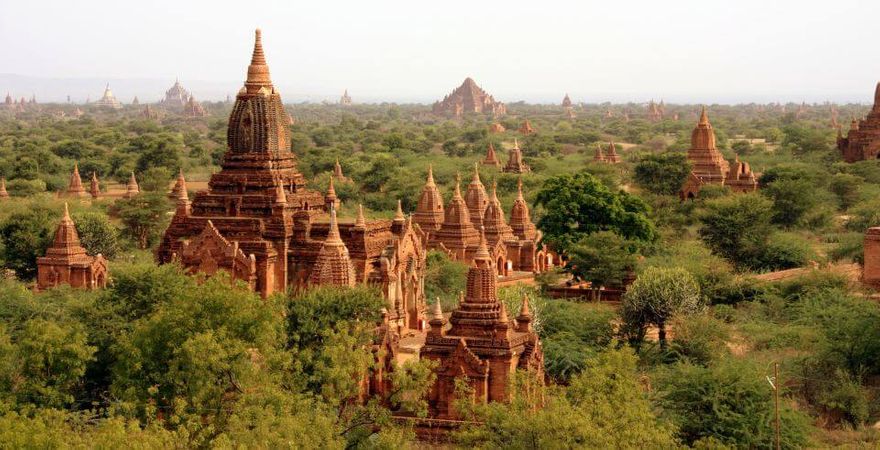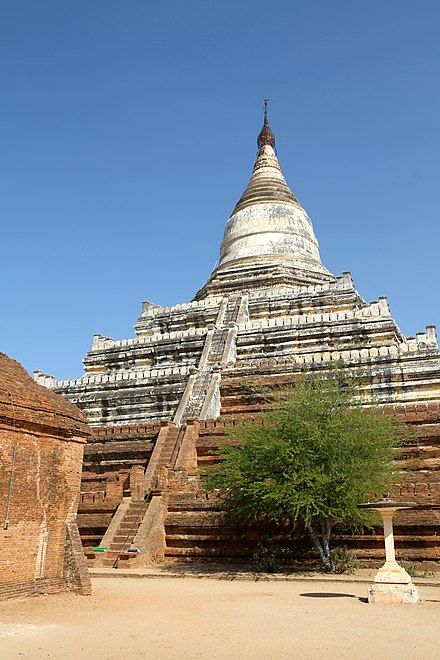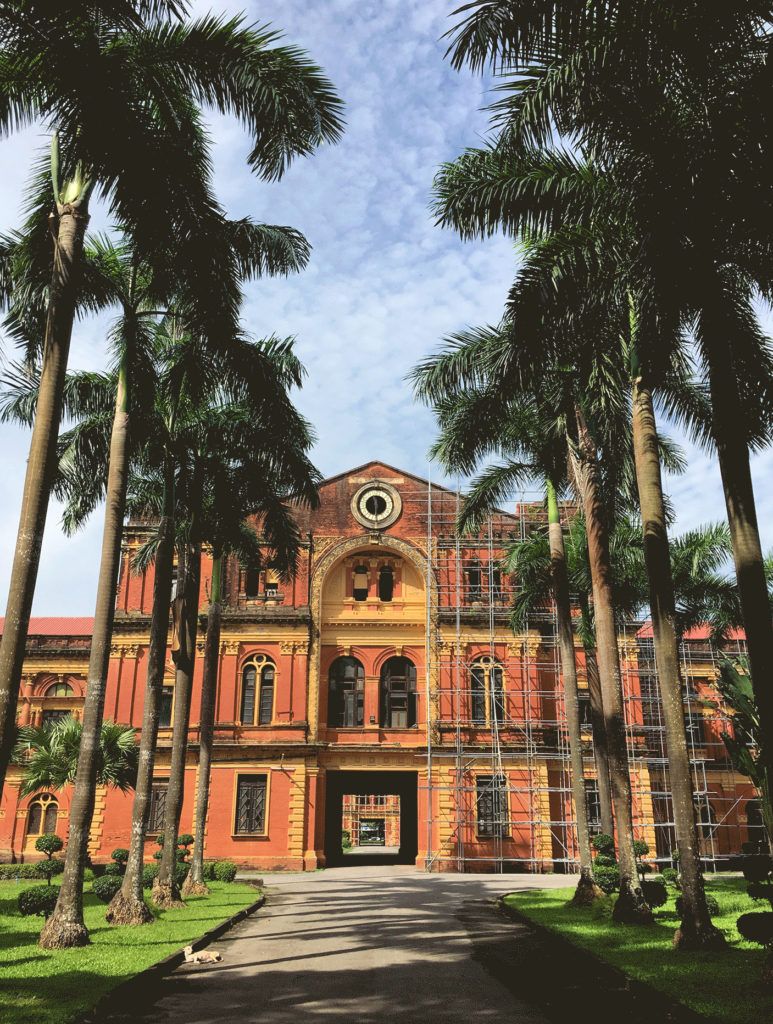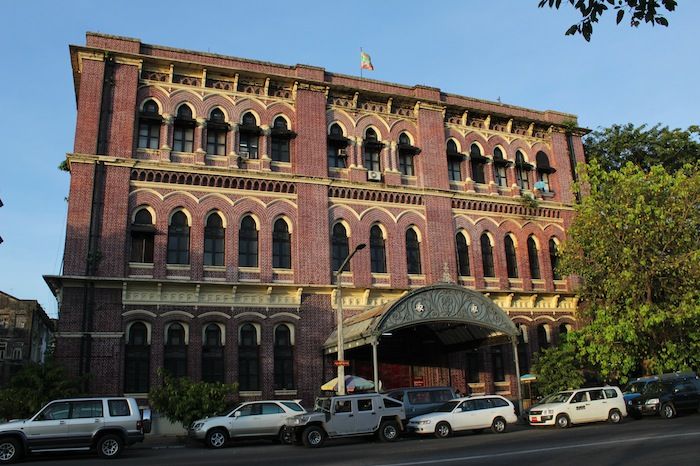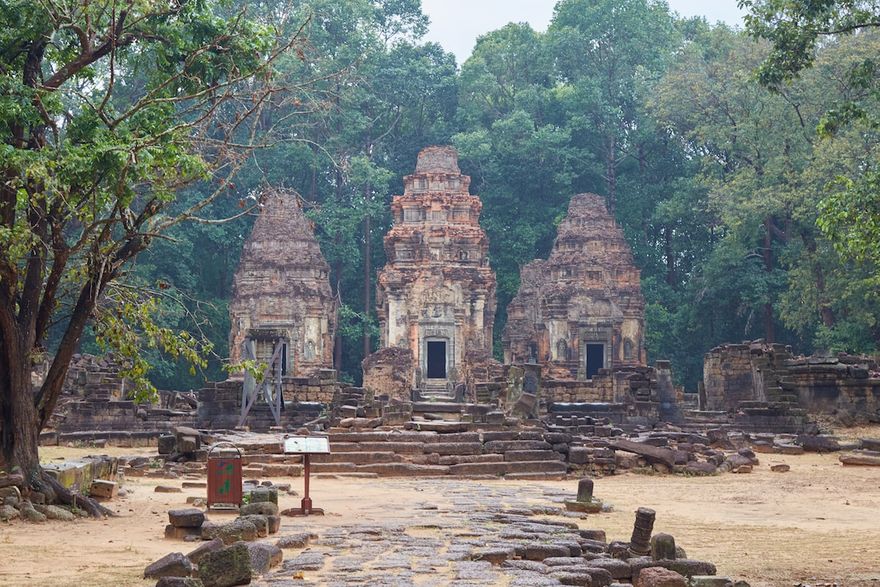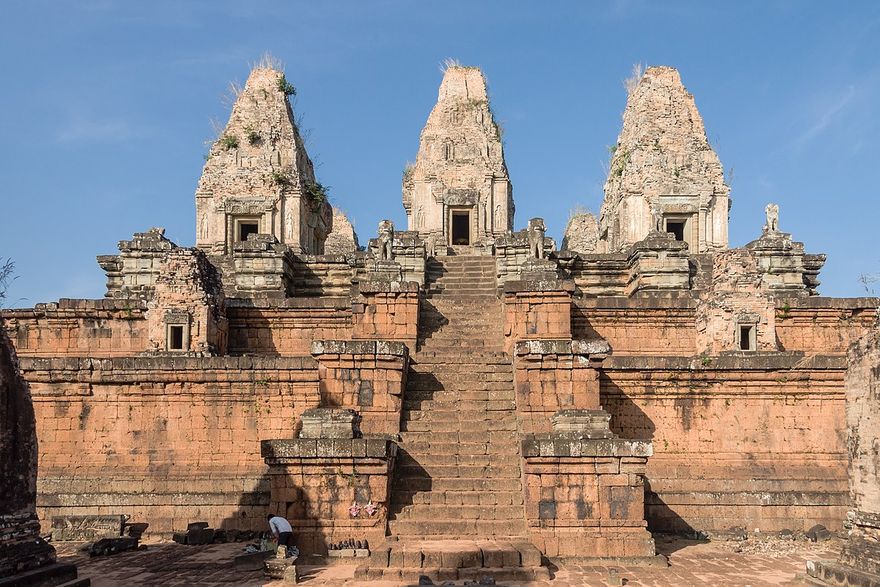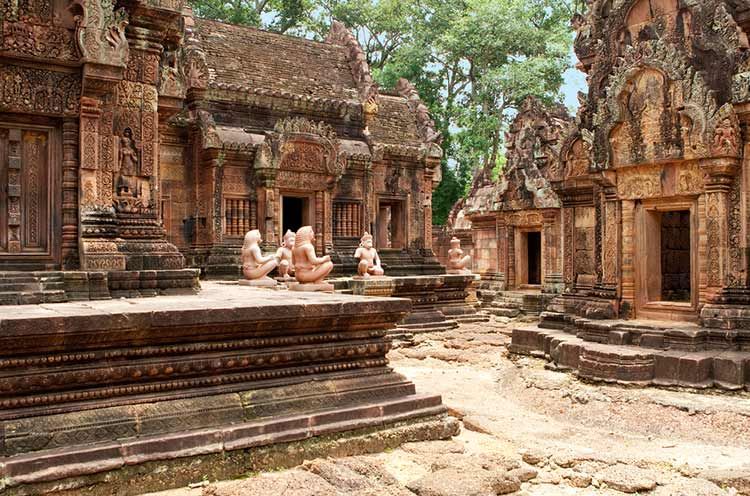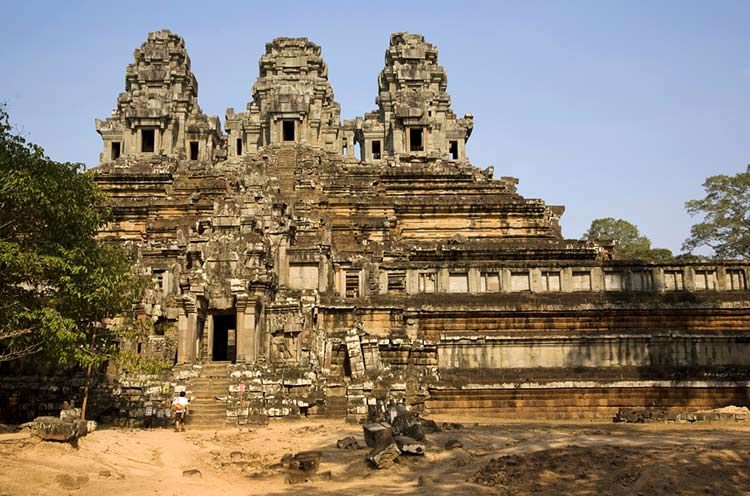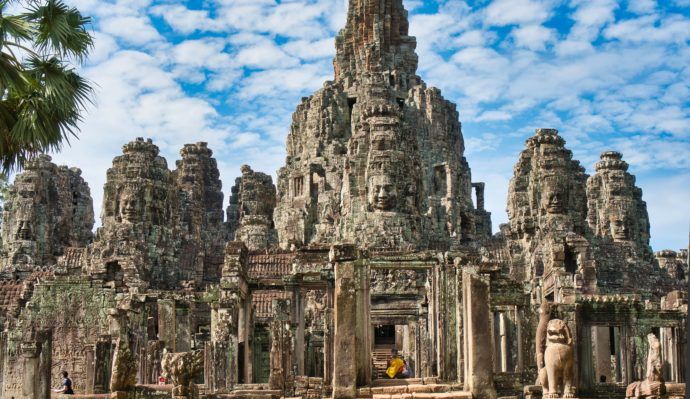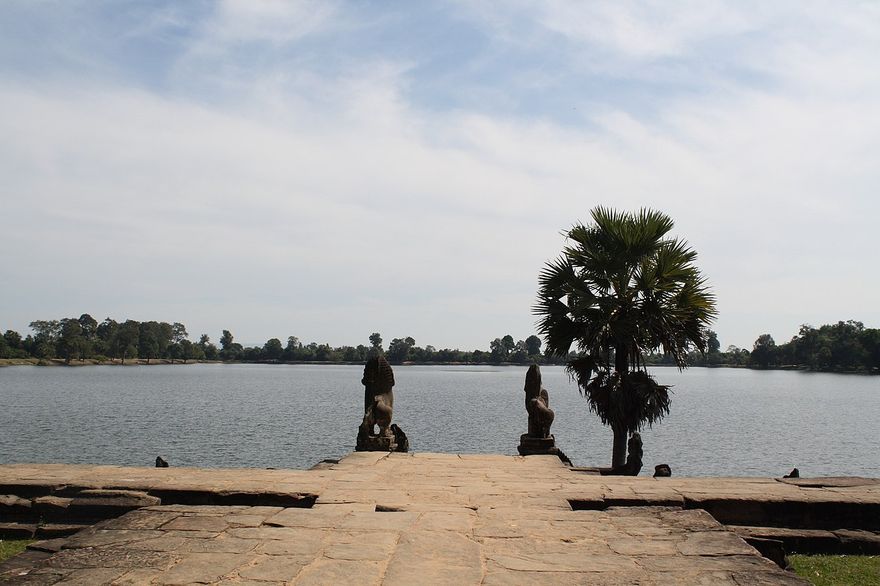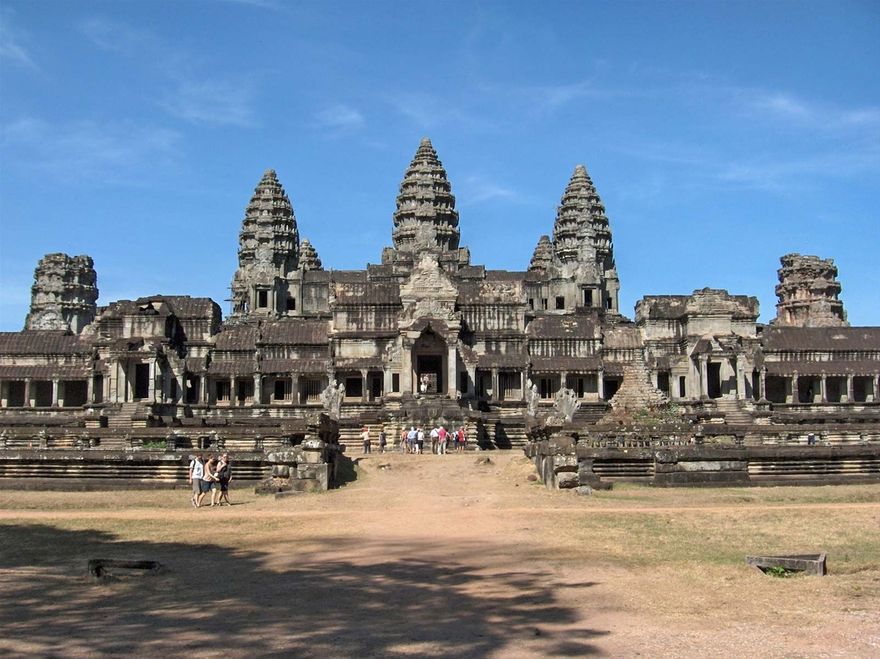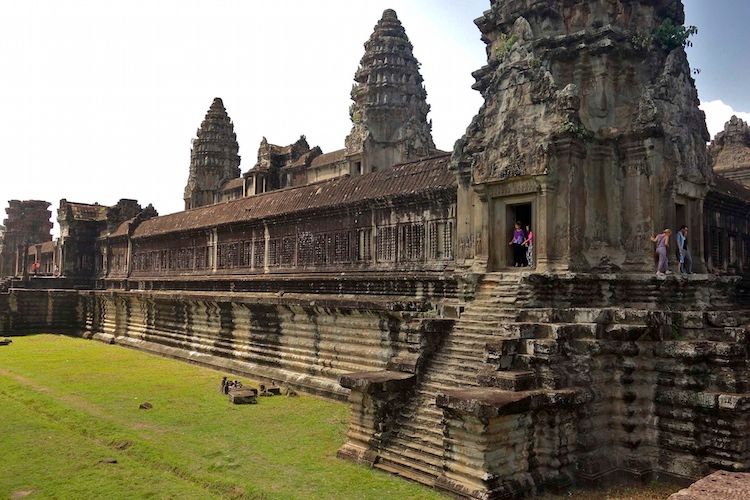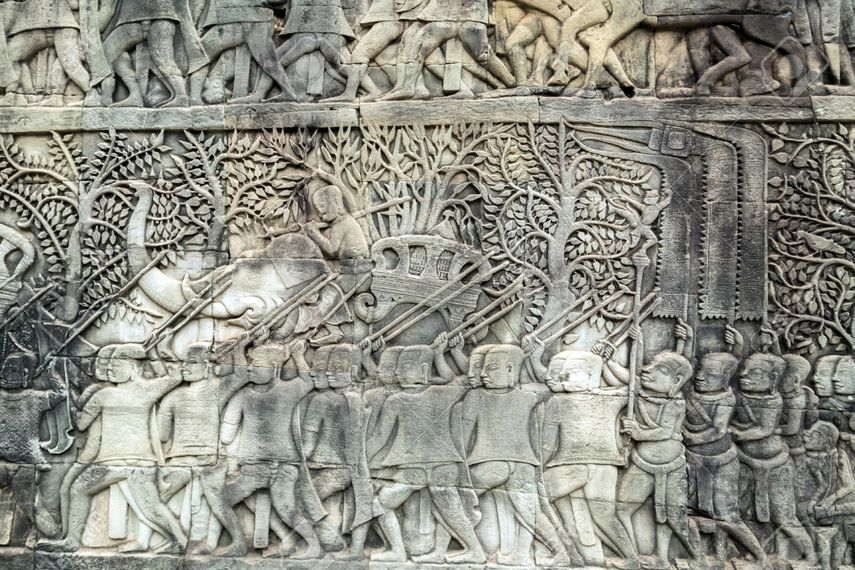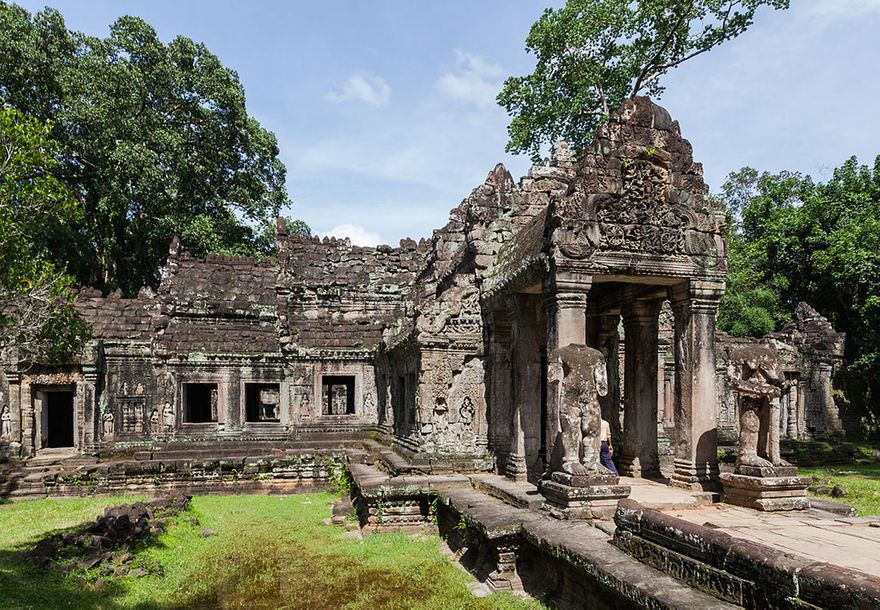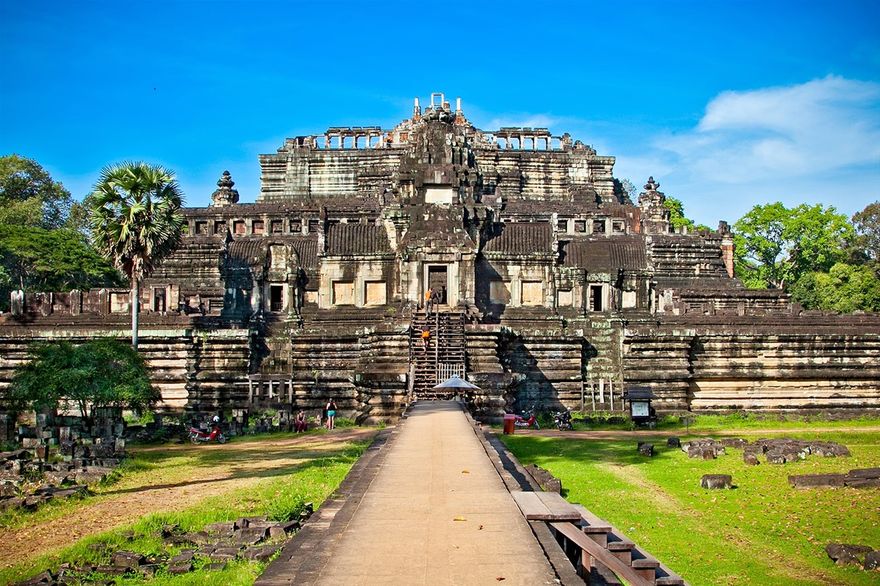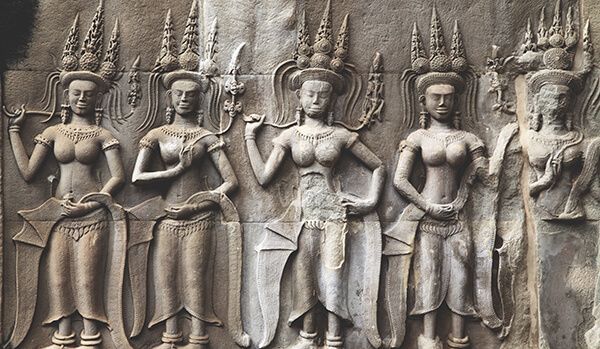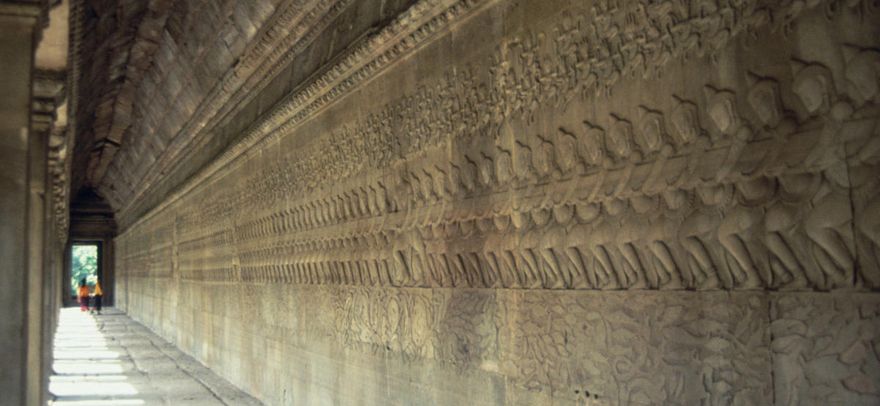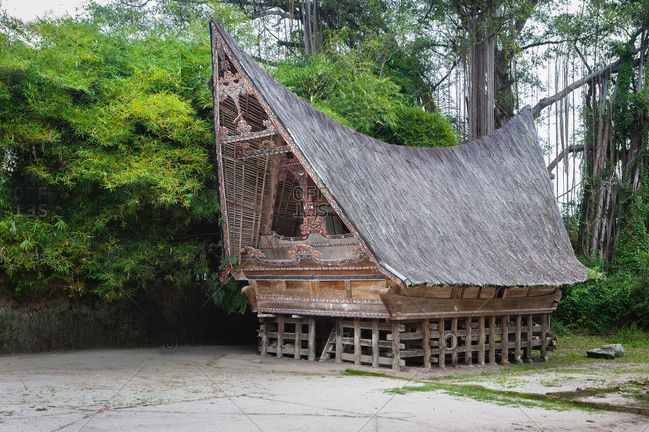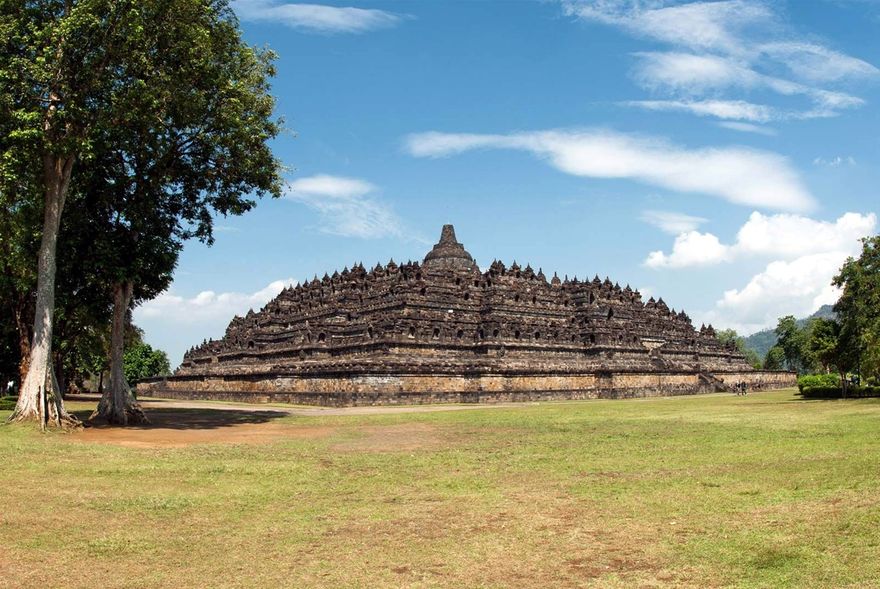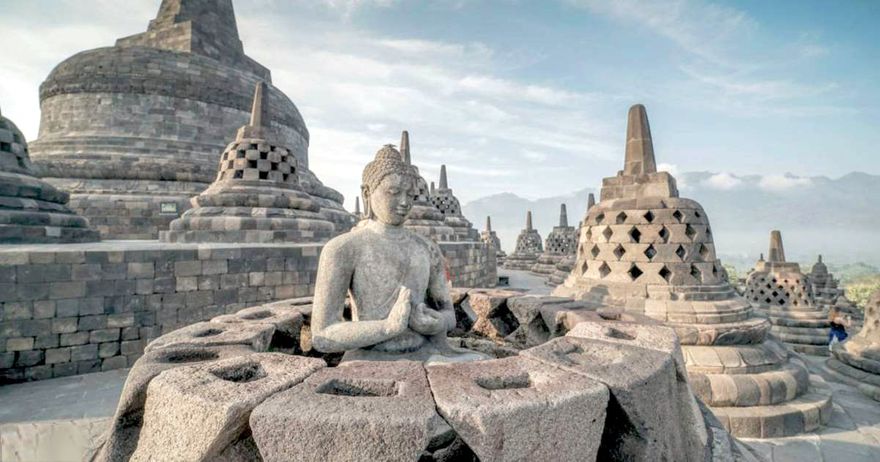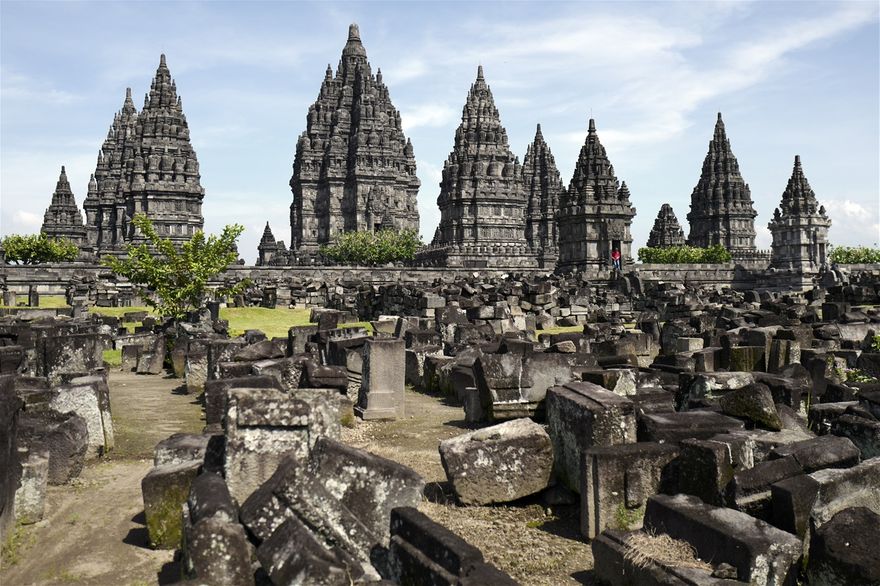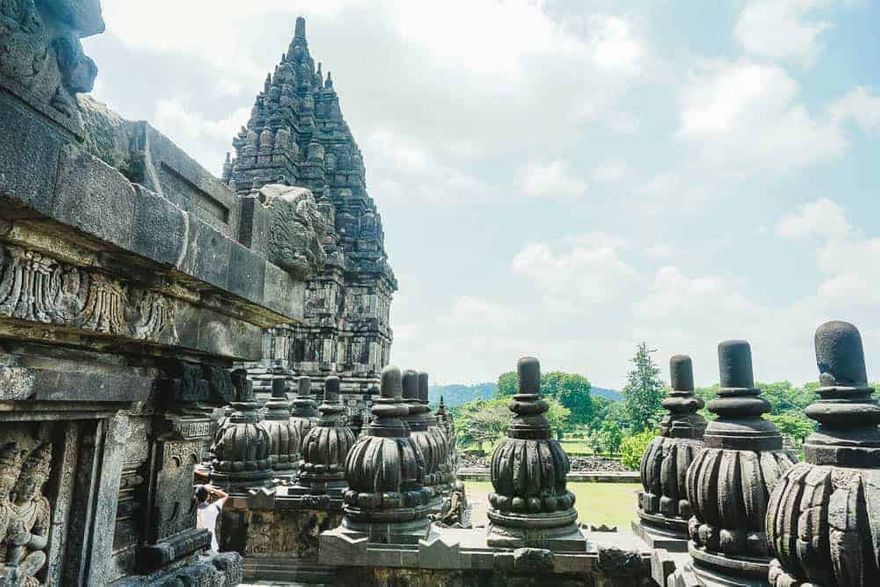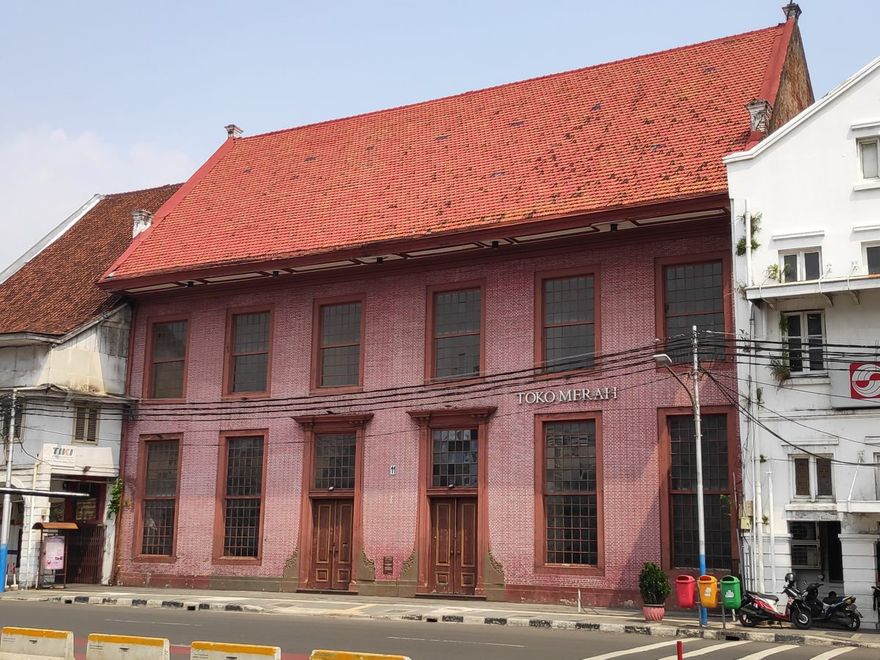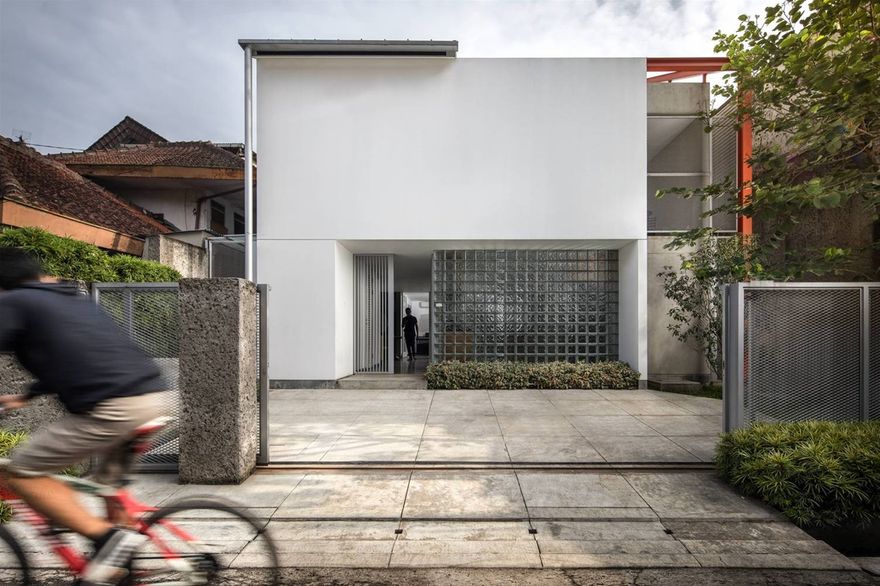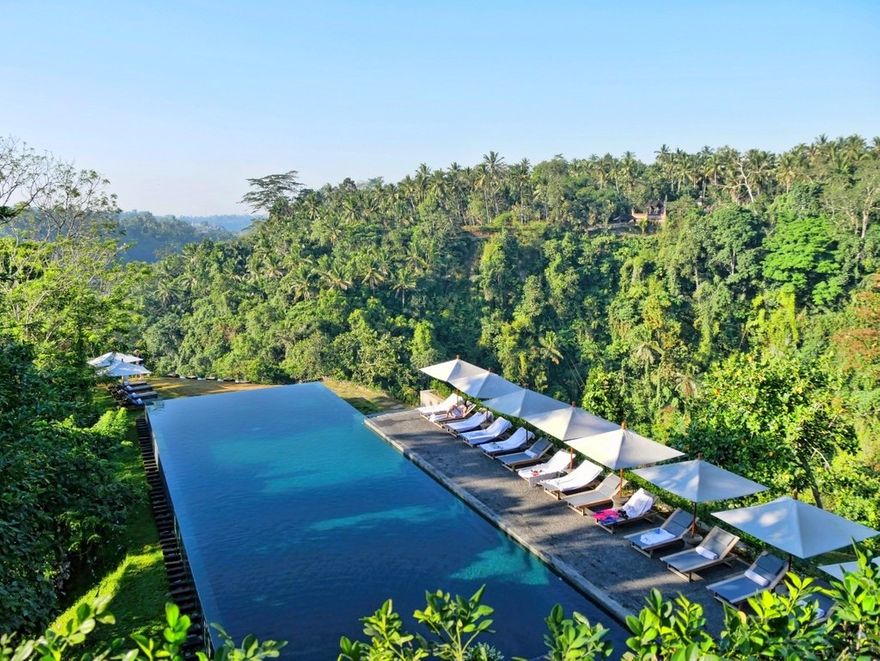Tesdorf Designs
Welcome to Architectural Information
SOUTH-EAST ASIAN ARCHITECTURE
A RESOURCE FOR THE STUDY OF THE HISTORY AND THEORY OF ARCHITECTURE IN MYANMAR, CAMBODIA, AND INDONESIA
MYANMAR ARCHITECTURE
OVERVIEW
The architecture of Myanmar (formerly known as Burma), in Southeast Asia, includes architectural styles which reflect the influence of neighboring and Western nations and modernization. The country's most prominent buildings include Buddhist pagodas, stupas and temples, British colonial buildings, and modern renovations and structures. Myanmar's traditional architecture is primarily used for worship, pilgrimage, storage of Buddhist relics, political activism, and tourism.
HISTORY AND INFLUENCES EARLY INDIAN INFLUENCE
Much of Myanmar's architecture is tied to ancient Indian culture and can be traced to the country's earliest known inhabitants. During the Pyu period, cylindrical stupas with four archways—often with an umbrella on top were built. The Mon and Pyu people were the first two influential groups to migrate to Myanmar, and the first Indo-Chinese adherents of Theravada Buddhism. Beikthano, one of the first Pyu centers, contains urbanesque foundations which include a monastery and stupa-like structures. These Pyu stupas, the first Indian foundations in Myanmar, were built from 200 B.C. to 100 A.D. and were sometimes used for burial. Early stupas, temples, and pagodas are topped with towers and finials or spires symbolizing Theravada Buddhist transcendence.
BAGAN (PAGAN) PERIOD
By the 9th century, the Bamar people had established a kingdom centered at Bagan. During the 11th century A.D., King Anawrahta unified the Irrawaddy Valley region and founded the Pagan Empire. Bagan, with over 10,000 of Myanmar's red brick stupas and pagodas, had become a center of Buddhist architecture by the mid-12th century A.D.. During this period, the Pyu-style stupas were transformed into monuments reminiscent of alms bowls or gourd-shaped domes, unbaked brick, tapered and rising roofs, Buddha niches, poly-lobed arches, and ornamental doorways influenced by India's Pala Empire and its monuments. Stucco was widely used in Bagan, especially by the Mon people. Stucco features of Bagan structures include garlands, flames or rays of the sun, peacock tail feathers and mythical creatures.
The Dhammayazika Pagoda has a plan similar to the Tantric Paharpur stupa in India. It does not have a square base like many Bagan stupas; instead, it has a pentagonal base with radial halls and low skirting.
The Ananda Temple (finished in 1090 A.D.), one of the first temples erected in Bagan, was influenced by Indian architecture. The vaulted temple represents the Theravada branch of Buddhism, Bagan's official religion when it was built. Architectural features of the temple include brick vaulted halls, Buddha statues, tapered roofs and the absence of terraces. The temple has one of the first uses of the pyatthat, or tiered roof, which indicates the presence of a throne within. With both royal and religious symbolism, many of the temple's images depict the Buddha seated before an odd number of pyatthat tiers. Many of Bagan's historical monuments are well-preserved, due to the dry climate. Bagan, with one of the largest concentrations of temples in the world, is one of Myanmar's most important pilgrimage sites.
Many of the temples' paintings and murals are still visible. Notable architectural sites in Bagan include the Bupaya Pagoda, the Dhammayangyi, Gawdawpalin and Htilominlo Temples, the Inn-hpaya Stupa, the Mahabodhi Temple, the Mingalazedi Pagoda, the Minochantha stupa group, the Taung Kyaung monastery, the Nathlaung Kyaung Temple, the Nga-kywe-na-daung Stupa, the Pahto Thamya and Shwegugyi Temples, the Shwezigon Pagoda and the Sulamani and Thatbyinnyu Temple.
COLONIAL ERA
Burma was part of the British Empire by the end of the 1880s, and this ushered in a period of colonial architecture. Rangoon, now known as Yangon, became a multi-ethnic capital. As large, colonial buildings were built throughout the city, social disruption in Burma spawned nationalist rallies and anti-colonial protests.
Yangon's central business district, along the Yangon River, contains many colonial-era buildings. One example is the Ministers' Building, built as the Secretariat Building in 1902 to house the British administration. Other downtown structures are the Bogyoke Market (formerly Scott Market) and the Strand Hotel, built in 1896 A.D. by Aviet and Tigran Sarkie. Prominent buildings include Yangon City Hall, built between 1926 and 1936; the Customs House; the High Court Building (built in 1914 and converted to the High Court head office in 1962); the 1920 Inland Water Transport Authority Building, and the former Myanmar Railways headquarters.
NOTABLE STRUCTURES
The Shwedagon Pagoda in Yangon is a stupa and a focal point of Buddhism in Myanmar. At 99.4 metres (326 ft) high, the stupa is covered with gold leaf and plate. It is surrounded by smaller shrines, and is topped with a gem-encrusted seinbu (diamond bud) and a seven-tiered hti representing Burmese spirituality. Every four or five years, its gold is repaired or replaced. The stupa, built by a Theravada Buddhist society, is said to contain strands of the Buddha's hair.
Built to be walked around, visitors pass astrological representations of the eight days of a Burmese week. The platform includes devotional centres at the cardinal compass points and dozens of smaller stupas, including the Golden Elder. Bodhi trees, images of the Buddha and other spiritual figures, and the 16-ton Singu Min Bell (formerly known as the Maha Ganda Bell) decorate the exterior.
The pagoda has been a centre of Buddhist devotion and a forum for political activism. During the anti-colonial demonstrations of the nationalist Thakin Party in 1938 and 1939, "strike centres" were set up around the pagoda. In 1988, as the Burmese Socialist Programme Party was collapsing, Shwedagon was a platform for pro-democracy political demonstrations. On 26 August 1988, Aung San Suu Kyi spoke before a large audience about democracy at the pagoda's west gate.
MANDALAY PALACE
The Mandalay Palace is an example of wooden architecture in Myanmar, which emphasizes exterior aesthetics rather than interior space. Built in the late 1850s A.D., some characteristics of the palace (such as cardinally-placed gates and a central palace structure) can be traced back to the early Pyu period. The primary east–west axis was constructed from the palace buildings themselves. Illustrations from 11th century A.D. Pagan depict wooden buildings similar to those at the palace, and handiwork later found at Mandalay. Only a section of the original palace remained after a 1945 fire, with examples of traditional stucco used in Burmese construction. The palace's Flower Distribution Centre contains several wooden, semicircular arches which may have been inspired by 19th-century A.D. European buildings. The stucco on these arches appears to represent rays of sunlight or lotus petals. In addition to its wood carvings and stucco, tiered roofs (pyatthat) are a feature of the palace. Inside, covered hallways lead to a small throne room which is topped by a pyatthat. Many pyatthats on the palace, like those other Burmese structures, are parallel to monasteries and throne rooms. There is also a pyatthat over the Great Audience Hall. Due to the tropical climate, frequent renovations of the wood-and-stucco palace have been necessary; some of its original teak has been reinforced with concrete.
Shwedagon Pagoda at Yangon (Rangoon) 6th-10th centuries A.D.
Royal Palace at Mandalay, built 1857-1859 A.D.
PAGAN ARCHITECTURE
Pagan Period or Pagan Dynasty was the first-ever kingdom that unified the regions and began to be known as Burma later in the period. Pagan ruled for almost 250 years over the Irrawaddy valley. The Pagans laid the foundations for the ascent of Burmese language and culture, the spread of Burman ethnicity in Upper Burma, and also the growth of Theravada Buddhism in Burma and in other southeast Asia.
Pagan Period also observed the construction of numerous Buddhist temples housing localized statues of Burmese Buddha in the capital zone, Bagan. These Buddhist temples were built in the tax-free land which was donated by the wealthy to religious authorities. Not only Buddhist temples, Pagan observed notable architecture built in this period which had significant importance in the present context as well.
PAGAN PERIOD ARCHITECTURE
Pagan period architecture can be broadly categorized into - religious and non-religious architecture. Both of the architecture has unique features and localized elements.
Hence, Pagan architecture is valued and is equally important even today. It has been recorded that the pilgrims visiting the Buddhist temples not only pay homage to Buddha statues but also enjoy the beauty of architecture. Further, the Pagan period Buddhist temple can be categorized into the following groups
STUPA-STYLE SOLID TEMPLE
A stupa often referred to as A Pagoda, is a massive structure that houses a Buddhist relic inside the chamber. It is recorded that the Pagan stupas have their origin from earlier Pyu designs which were inspired by the stupa designs of the Andhra region of present-day southeastern India and to a smaller extent to Ceylon. Originally, an Indian/Ceylonese stupa had a hemispheric body above which a rectangular box surrounded by a stone balustrade is built on. Above the rectangular box, a shaft with several ceremonial umbrellas was extended up to the top of the stupa. It is believed that the stupa is a representation of the Buddhist cosmos since its shape symbolizes Mount Meru while the umbrella represents the world's axis. This Indian design of Stupa was localized during the Pyu Period and then Burmans at Pagan gradually developed a longer, cylindrical form.
The earliest Pagan stupas, Bupaya - built during the 9th century - were the direct descendants of the Pyu style at Sri Ksetra. As time moved on, the stupa had developed into a more bell-shaped form in which the parasols morphed into a series of increasingly smaller rings placed on one top of the other, rising to a point. On the top of the stupa, the new design lotus bud replaced the balustrade. Later the lotus bud was also modified into the banana bud, which forms the extended apex of most Burmese pagodas. Three or four rectangular terraces served as the base for a pagoda, often with a Buddhist art gallery of terra-cotta tiles depicting Buddhist Jataka stories.
GU-STYLE SOLID TEMPLE
It is a vaulted Buddhist temple with a pentagonal floor plan. The Gu-style hollow temple is a structure used mainly for meditation, devotional worship of the Buddha, and other Buddhist rituals. The Gu-style hollow temple can also be categorized into two basic styles - one face design and four face designs. The one-face-designed hollow temple has one main entrance while the four face designs have four main entrances. The one-face style was inspired by 2nd-century Beikthano while the four-face was inspired by 7th century Sri Ksetra. Sometimes, we can observe other styles of hollow temples such as five-face and hybrids.
VAULTED TEMPLES
Along with the stupa style and hollow style temples, vaulted temples were also observed during the pagan period. It is believed that the techniques of vaulting were developed in Pagan. The earliest vaulted temples in Pagan were constructed in the 11th century while the vaulting technique didn't become widespread in India until the late 12th century. But unfortunately, the vaulting techniques were lost in the later periods.
BUDDHIST TEMPLE WITH A PENTAGONAL PLAN
This style of Buddhist temple was also originated in Pagan. This style was evolved with the fusion of two different designs of a Gu-style Hollow temple - one face and four face designs. The idea to fuse the designs was initiated with the idea to include the statue of Maitreya Buddha in addition to the statue of four other Buddhas who had already appeared. The best example of this pentagonal design is Dhammayazika and Ngamyethna Pagoda.
Thatbinnyu Temple at Pagan, built 1150–1151 A.D.
Sulamani Pagoda at Pagan built 1181 A.D.
View from Dhamma Za Yi Ka Pagoda at Pagan
Shwesandaw Pagoda at Pagan completed by 1102 A.D.
FEATURES OF MATERIALS
Stucco, introduced during the Bagan period, is strongly tied to Mon heritage. Wood carving in Myanmar is a traditional art that has survived for centuries. Due to its tropical climate (necessitating the reconstruction of many buildings), the craft has been passed down from generation to generation. Without these renovations, the art of wood carving would have been lost and it would have been impossible to reconstruct traditional features.
USE OF GOLD
Gold cladding is a feature of traditional Burmese architecture, usually prominent in gilded or gold-plated exteriors. The Bupaya, Shwedagon, Shwezigon, and Lawkananda Pagodas have gold features. THREATS During World War II, many historical structures were lost or damaged; much of the Mandalay Palace was destroyed in a fire near the end of the war. In 1962, on alleged orders from Ne Win, the Rangoon University Students' Union was demolished (although the main campus still contains lecture and residence halls from the colonial period). Since the late 1980s, many colonial structures (including a block of cinemas) have been razed for new construction.
PRESERVATION AND RECONSTRUCTION
Only a few colonial-era buildings and about 2,200 temples and pagodas remain in Myanmar. As a result of these losses, many groups have united to preserve the remaining structures. The Yangon City Development Committee, established in 1990, has worked with the State Peace and Development Council to recondition many Buddhist monuments with plans for newer and more-challenging designs. Pagodas and temples have been renovated to promote "monumental Buddhism", the renewal of Buddhist architecture for a sense of authenticity.
These newer Buddhist sites, a combination of modern and traditional Burmese style, are found throughout Myanmar and include monasteries, pagodas, and the International Theravada Buddhist Missionary University. The crown umbrella atop the Shwedagon Pagoda, which was donated by King Mindon in 1871, was replaced in the spring of 1999. The Yangon Heritage Trust, formed in 2012, is a non-governmental organization committed to preserving Yangon's historic architecture.
The trust has had several preservation successes, due to its public-awareness campaigns. Agreements with government officials have saved the former Indian and U.S. Embassy buildings and Gandhi Hall.
Secretariat Building in Rangoon built 1899-1905 architect Henry Hoyne-Fox
Bulloch Bros & Co. Building, Strand Road, Rangoon, currently a Post Office, built 1908.
ARCHITECTURE OF CAMBODIA
KHMER ARCHITECTURE OF CAMBODIA
The 12th-century temple A.D.of Angkor Wat is the masterpiece of Angkorian architecture. Constructed under the direction of the Khmer king Suryavarman II, it was to serve as the monarch's personal mausoleum and as a temple to the Hindu god Vishnu. Based on Dravidian architecture, it was designed as a pyramid representing the structure of the universe: the highest level at the center of the temple represented Mount Meru, the home of the Hindu gods, with the five towers on the highest level representing the five peaks of the mountain. The broad moat around the complex represented the oceans that surround the world.
Khmer architecture (Khmer: ស្ថាបត្យកម្មខ្មែរ), also known as Angkorian architecture is the architecture produced by the Khmers during the Angkor period of the Khmer Empire from approximately the latter half of the 8th century CE to the first half of the 15th century A.D.. The architecture of the Indian rock-cut temples, particularly the sculptures, were widely adopted in South India, and Indianised architecture of Cambodian, Annamese (Khmer), and Javanese temples (of the Greater India). In any study of Angkorian architecture, the emphasis is necessarily on religious architecture, since all the remaining Angkorian buildings are religious in nature.
During the period of Angkor, only temples and other religious buildings were constructed of stone. Non-religious buildings such as dwellings were constructed of perishable materials such as wood, and so have not survived. The religious architecture of Angkor has characteristic structures, elements, and motifs, which are identified in the glossary below. Since a number of different architectural styles succeeded one another during the Angkorean period, not all of these features were equally in evidence throughout the period. Indeed, scholars have referred to the presence or absence of such features as one source of evidence for dating the remains.
PERIODS
Many temples had been built before Cambodia became a powerful Kingdom of the Khmer Empire which dominated most of the Indochina region. At that time, Cambodia was known as the Chenla kingdom, the predecessor state of the Khmer empire. There are three pre-Angkorean architectural styles:
Sambor Prei Kuk style (610–650 A.D.): Sambor Prei Kuk, also known as Isanapura, was the capital of the Chenla Kingdom. Temples of Sambor Prei Kuk were built in rounded, plain colonettes with capitals that include a bulb.
Prei Khmeng style (635–700 A.D.): Structures reveal masterpieces of sculpture but examples are scarce. Colonettes are larger than those of previous styles. Buildings were more heavily decorated but had a general decline in standards.
Kompong Preah style (700–800 A.D.): Temples with more decorative rings on colonettes that remain cylindrical. Brick constructions were being continued. Scholars have worked to develop a periodization of Angkorean architectural styles. The following periods and styles may be distinguished. Each is named for a particular temple regarded as paradigmatic for the style.
Kulen style (825–875 A.D.): Continuation of pre-Angkorean style but it was a period of innovation and borrowing such as from Cham temples. The tower is mainly square and relatively high as well as a brick with laterite walls and stone door surrounds but square and octagonal colonettes begin to appear.
Preah Ko style (877–886 A.D.): Hariharalaya was the first capital city of the Khmer empire located in the area of Angkor; its ruins are in the area now called Roluos some fifteen kilometers southeast of the modern city of Siem Reap. The earliest surviving temple of Hariharalaya is Preah Ko; the others are Bakong and Lolei. The temples of the Preah Ko style are known for their small brick towers and for the great beauty and delicacy of their lintels.
Bakheng Style (889–923 A.D.): Bakheng was the first temple-mountain constructed in the area of Angkor proper north of Siem Reap. It was the state temple of King Yasovarman, who built his capital of Yasodharapura around it. Located on a hill (Phnom), it is currently one of the most endangered of the monuments, having become a favorite perch for tourists eager to witness a glorious sundown at Angkor.
Koh Ker Style (921–944 A.D.): During the reign of King Jayavarman IV, the capital of the Khmer empire was removed from the Angkor region through the north which is called Koh Ker. In the architectural style of temples in Koh Ker, the scale of buildings diminishes toward centre. Brick is still the main material but sandstone is also used.
Pre Rup Style (944–968 A.D.): Under King Rajendravarman, the Angkorian Khmer built the temples of Pre Rup, East Mebon, and Phimeanakas. Their common style is named after the state temple mountain of Pre Rup.
Banteay Srei Style (967–1000 A.D.): Banteay Srei is the only major Angkorian temple constructed not by a monarch, but by a courtier. It is known for its small scale and the extreme refinement of its decorative carvings, including several famous narrative bas-reliefs dealing with scenes from Indian mythology.
Khleang Style (968–1010 A.D.): The Khleang temples, the first use of galleries. Cruciform gopuras. Octagonal colonettes. Restrained decorative carving. A few temples that were built in this style are Ta Keo, Phimeanakas.
Baphuon Style (1050–1080 A.D.): Baphuon, the massive temple mountain of King Udayadityavarman II was apparently the temple that most impressed the Chinese traveler Zhou Daguan, who visited Angkor toward the end of the 13th century A.D.. Its unique relief carvings have a naive dynamic quality that contrasts with the rigidity of the figures typical of some other periods. As of 2008, Baphuon is under restoration and cannot currently be appreciated in its full magnificence. Classical or
Angkor Wat Style (1080–1175 A.D.): Angkor Wat, the temple and perhaps the mausoleum of King Suryavarman II, is the greatest of the Angkorian temples and defines what has come to be known as the classical style of Angkorian architecture. Other temples in this style are Banteay Samre and Thommanon in the area of Angkor, and Phimai in modern Thailand.
Bayon Style (1181–1243 A.D.): In the final quarter of the 12th century, A.D. King Jayavarman VII freed the country of Angkor from occupation by an invasionary force from Champa. Thereafter, he began a massive program of monumental construction, paradigmatic for which was the state temple called the Bayon. The king's other foundations participated in the style of the Bayon and included Ta Prohm, Preah Khan, Angkor Thom, and Banteay Chmar. Though grandiose in plan and elaborately decorated, the temples exhibit a hurriedness of construction that contrasts with the perfection of Angkor Wat.
Post Bayon Style (1243–1431 A.D.): Following the period of frantic construction under Jayavarman VII, Angkorian architecture entered the period of its decline. The 13th century Terrace of the Leper King is known for its dynamic relief sculptures of demon kings, dancers, and nāgas.
MATERIALS
Angkorian builders used brick, sandstone, laterite, and wood as their materials. The ruins that remain are of brick, sandstone, and laterite, the wood elements having been lost to decay and other destructive processes.
BRICK
The earliest Angkorian temples were made mainly of brick. Good examples are the temple towers of Preah Ko, Lolei and Bakong at Hariharalaya. Decorations were usually carved into a stucco applied to the brick, rather than into the brick itself. This is because bricks being softer material do not lend themselves to sculpting as opposed to stones of different kinds such as the Sandstones or the Granites. However, the tenets of the Sacred Architecture as enunciated in the Vedas and the Shastras, require no adhesives to be used while building blocks are assembled one over the other to create the Temples, as such bricks have been used only in relatively smaller temples such as Lolei and The Preah Ko. Besides, the strength of bricks is much lesser as compared to the stones (mentioned here-in) and the former degrade with age.
Angkor's neighbor state of Champa was also the home to numerous brick temples that are similar in style to those of Angkor. The most extensive ruins are at Mỹ Sơn in Vietnam. A Cham story tells of the time that the two countries settled an armed conflict by means of a tower-building contest proposed by the Cham King Po Klaung Garai. While the Khmer built a standard brick tower, Po Klaung Garai directed his people to build an impressive replica of paper and wood. In the end, the Cham replica was more impressive than the real brick tower of the Khmer, and the Cham won the contest.
SANDSTONE
The only stone used by Angkorian builders was sandstone, obtained from the Kulen mountains. Since its obtainment was considerably more expensive than that of brick, sandstone only gradually came into use, and at first, was used for particular elements such as door frames. The 10th-Century A.D. temple of Ta Keo is the first Angkorian temple to be constructed more or less entirely from Sandstone.
LATERITE
Angkorian builders used laterite, a clay that is soft when taken from the ground but that hardens when exposed to the sun, for foundations and other hidden parts of buildings. Because the surface of laterite is uneven, it was not suitable for decorative carvings, unless first dressed with stucco. Laterite was more commonly used in the Khmer provinces than at Angkor itself. Because the water table in this entire region is well high, Laterite has been used in the underlying layers of Angkor Wat and other temples (especially the larger ones), because it can absorb water and help towards better stability of the Temple.
Preah Ko Temple at Angkor built 879 A.D.
Pre Rup Temple at Angkor (944–968 A.D.)
Banteay Srei Temple near Angkor built 967 A.D.
Ta Keo Temple at Angkor built around 1000 A.D.
The Bayon at Angkor built about 1200 A.D.
STRUCTURES
CENTRAL SANCTUARY
The central sanctuary of an Angkorian temple was home to the temple's primary deity, the one to whom the site was dedicated: typically Shiva or Vishnu in the case of a Hindu temple, Buddha or a bodhisattva in the case of a Buddhist temple. The deity was represented by a statue (or in the case of Shiva, most commonly by a linga).
Since the temple was not considered a place of worship for use by the population at large, but rather a home for the deity, the sanctuary needed only to be large enough to hold the statue or linga; it was never more than a few metres across. Its importance was instead conveyed by the height of the tower (prasat) rising above it, by its location at the centre of the temple, and by the greater decoration on its walls. symbolically, the sanctuary represented Mount Meru, the legendary home of the Hindu gods.
PRANG
The prang is the tall finger-like spire, usually richly carved, common to much Khmer religious architecture.
ENCLOSURE
Khmer temples were typically enclosed by a concentric series of walls, with the central sanctuary in the middle; this arrangement represented the mountain ranges surrounding Mount Meru, the mythical home of the gods. Enclosures are the spaces between these walls, and between the innermost wall and the temple itself. By modern convention, enclosures are numbered from the centre outwards.
The walls defining the enclosures of Khmer temples are frequently lined by galleries, while passage through the walls is by way of gopuras located at the cardinal points. A gallery is a passageway running along the wall of an enclosure or along the axis of a temple, often open to one or both sides. Historically, the form of the gallery evolved during the 10th century from the increasingly long hallways which had earlier been used to surround the central sanctuary of a temple.
During the period of Angkor Wat in the first half of the 12th Century A.D., additional half galleries on one side were introduced to buttress the structure of the temple. A gopura is an entrance building. At Angkor, passage through the enclosure walls surrounding a temple compound is frequently accomplished by means of an impressive gopura, rather than just an aperture in the wall or a doorway.
Enclosures surrounding a temple are often constructed with a gopura at each of the four cardinal points. In plan, gopuras are usually cross-shaped and elongated along the axis of the enclosure wall; if the wall is constructed with an accompanying gallery, the gallery is sometimes connected to the arms of the gopura. Many Angkorian gopuras have a tower at the centre of the cross. The lintels and pediments are often decorated, and guardian figures (dvarapalas) are often placed or carved on either side of the doorways.
HALL OF DANCERS
A Hall of Dancers is a structure of a type found in certain late 12th-century temples constructed under King Jayavarman VII: Ta Prohm, Preah Khan, Banteay Kdei, and Banteay Chhmar. It is a rectangular building elongated along the temple's east axis and divided into four courtyards by galleries. Formerly it had a roof made of perishable materials; now only the stone walls remain. The pillars of the galleries are decorated with carved designs of dancing apsaras; hence scholars have suggested that the hall itself may have been used for dancing.
HOUSE OF FIRE
House of Fire, or Dharmasala, is the name given to a type of building found only in temples constructed during the reign of late 12th-century monarch Jayavarman VII: Preah Khan, Ta Prohm, and Banteay Chhmar. A House of Fire has thick walls, a tower at the west end, and south-facing windows. Scholars theorize that the House of Fire functioned as a "rest house with fire" for travelers. An inscription at Preah Khan tells of 121 such rest houses lining the highways into Angkor. The Chinese traveler Zhou Daguan expressed his admiration for these rest houses when he visited Angkor in 1296 A.D.. Another theory is that the House of Fire had a religious function as the repository of the sacred flame used in sacred ceremonies.
LIBRARY
Structures conventionally known as "libraries" are a common feature of Khmer temple architecture, but their true purpose remains unknown. Most likely they functioned broadly as religious shrines rather than strictly as repositories of manuscripts. Freestanding buildings were normally placed in pairs on either side of the entrance to an enclosure, opening to the west.
SRAH AND BARAY
Srahs and barays were reservoirs, generally created by excavation and embankment, respectively. It is not clear whether the significance of these reservoirs was religious, agricultural, or a combination of the two. The two largest reservoirs at Angkor were the West Baray and the East Baray located on either side of Angkor Thom. The East Baray is now dry. The West Mebon is an 11th-Century A.D. temple standing at the center of the West Baray and the East Mebon is a 10th-Century A.D. temple standing at the center of the East Baray.
The Baray associated with Preah Khan is the Jayataka, in the middle of which stands the 12th-Century A.D. temple of Neak Pean. Scholars have speculated that the Jayataka represents the Himalayan lake of Anavatapta, known for its miraculous healing powers. The dominant scheme for the construction of state temples in the Angkorian period was that of the Temple Mountain, an architectural representation of Mount Meru, the home of the gods in Hinduism.
The style was influenced by South Indian temple architecture. Enclosures represented the mountain chains surrounding Mount Meru, while a moat represented the ocean. The temple itself took shape as a pyramid of several levels, and the home of the gods was represented by the elevated sanctuary at the center of the temple. The first great temple-mountain was the Bakong, a five-level pyramid dedicated in 881 A.D. by King Indravarman I.
The structure of Bakong took shape of a stepped pyramid, popularly identified as a temple mountain of early Khmer temple architecture. The striking similarity of the Bakong and Borobudur in Java, going into architectural details such as the gateways and stairs to the upper terraces, strongly suggests that Borobudur might serve as the prototype of Bakong. There must have been exchanges of travelers, if not missions, between the Khmer kingdom and the Sailendras in Java. Transmitting to Cambodia not only ideas but also technical and architectural details of Borobudur, including arched gateways in the corbelling method. Other Khmer temple mountains include Baphuon, Pre Rup, Ta Keo, Koh Ker, the Phimeanakas, and most notably the Phnom Bakheng at Angkor.
According to Charles Higham, "A temple was built for the worship of the ruler, whose essence, if a Saivite, was embodied in a linga... housed in the central sanctuary which served as a temple-mausoleum for the ruler after his death...these central temples also contained shrines dedicated to the royal ancestors and thus became centres of ancestor worship."
ELEMENTS
BAS-RELIEF
Bas-reliefs are individual figures, groups of figures or entire scenes cut into stone walls, not as drawings but as sculpted images projecting from a background. Sculpture in bas-relief is distinguished from a sculpture in haut-relief, in that the latter projects farther from the background, in some cases almost detaching itself from it. The Angkorian Khmer preferred to work in bas-relief, while their neighbors the Cham were partial to haut-relief.
Narrative bas-reliefs are bas-reliefs depicting stories from mythology or history. Until about the 11th century A.D., the Angkorian Khmer confined their narrative bas-reliefs to the space on the tympana above doorways. The most famous early narrative bas-reliefs are those on the tympana at the 10th-Century A.D. temple of Banteay Srei, depicting scenes from Hindu mythology as well as scenes from the great works of Indian literature, the Ramayana and the Mahabharata.
By the 12th century A.D., however, the Angkorian artists were covering entire walls with narrative scenes in bas-relief. At Angkor Wat, the external gallery wall is covered with some 12,000 or 13,000 square meters of such scenes, some of the historical, some mythological. Similarly, the outer gallery at the Bayon contains extensive bas-reliefs documenting the everyday life of the medieval Khmer as well as historical events from the reign of King Jayavarman VII.
The following is a listing of the motifs illustrated in some of the more famous Angkorian narrative bas-reliefs:
bas-reliefs in the tympana at Banteay Srei (10th century A.D.)
the duel of the monkey princes Vali and Sugriva, and the intervention of the human hero Rama on behalf of the latter
the duel of Bhima and Duryodhana at the Battle of Kurukshetra
the Rakshasa king Ravana shaking Mount Kailasa, upon which sit
Shiva and his shakti Kama firing an arrow at Shiva as the latter sits on Mount Kailasa
the burning of Khandava Forest by Agni and Indra's attempt to extinguish the flames
bas-reliefs on the walls of the outer gallery at Angkor Wat (mid-12th century A.D.)
the Battle of Lanka between the Rakshasas and the Vanaras or monkeys
the court and procession of King Suryavarman II, the builder of Angkor Wat
the Battle of Kurukshetra between Pandavas and Kauravas
the judgment of Yama and the tortures of Hell
the Churning of the Ocean of Milk a battle between devas and asuras
a battle between Vishnu and a force of asuras
the conflict between Krishna and the asura Bana
the story of the monkey princes Vali and Sugriva
bas-reliefs on the walls of the outer and inner galleries at the Bayon (late 12th century A.D.)
battles on land and sea between Khmer and Cham troops
scenes from the everyday life of Angkor
civil strife among the Khmer
the legend of the Leper King
the worship of Shiva groups of dancing apsaras
The West Baray at Angkor, from the mid 11th. Century. One of the largest handcut water reservoirs on Earth at 53 Million cubic metres.
Angkor Wat Temple built in early 12th. Century A.D.
Angkor Wat Temple Entry 12th. entury A.D.
ELEMENTS BAS-RELIEF
Bas-reliefs are individual figures, groups of figures, or entire scenes cut into stone walls, not as drawings but as sculpted images projecting from a background. Sculpture in bas-relief is distinguished from sculpture in haut-relief, in that the latter projects farther from the background, in some cases almost detaching itself from it.
The Angkorian Khmer preferred to work in bas-relief, while their neighbors the Cham were partial to haut-relief. Narrative bas-reliefs are bas-reliefs depicting stories from mythology or history. Until about the 11th Century A.D., the Angkorian Khmer confined their narrative bas-reliefs to the space on the tympana above doorways.
The most famous early narrative bas-reliefs are those on the tympana at the 10th-century temple of Banteay Srei, depicting scenes from Hindu mythology as well as scenes from the great works of Indian literature, the Ramayana and the Mahabharata. By the 12th century, however, the Angkorian artists were covering entire walls with narrative scenes in bas-relief. At Angkor Wat, the external gallery wall is covered with some 12,000 or 13,000 square meters of such scenes, some of the historical, some mythological. Similarly, the outer gallery at the Bayon contains extensive bas-reliefs documenting the everyday life of the medieval Khmer as well as historical events from the reign of King Jayavarman VII.
The following is a listing of the motifs illustrated in some of the more famous Angkorian narrative bas-reliefs:
bas-reliefs in the tympana at Banteay Srei (10th century)
the duel of the monkey princes Vali and Sugriva, and the intervention of the human hero Rama on behalf of the latter
the duel of Bhima and Duryodhana at the Battle of Kurukshetra the Rakshasa king Ravana shaking Mount Kailasa, upon which sit Shiva and his shakti Kama firing an arrow at Shiva as the latter sits on Mount Kailasa
the burning of Khandava Forest by Agni and Indra's attempt to extinguish the flames bas-reliefs on the walls of the outer gallery at Angkor Wat (mid-12th century A.D.)
the Battle of Lanka between the Rakshasas and the vanaras or monkeys the court and procession of King Suryavarman II, the builder of Angkor Wat
the Battle of Kurukshetra between Pandavas and Kauravas the judgment of Yama, and the tortures of Hell the Churning of the Ocean of Milk
a battle between devas and asuras a battle between Vishnu and a force of asuras
the conflict between Krishna and the asura Bana
the story of the monkey princes Vali and Sugriva bas-reliefs on the walls of the outer and inner galleries at the Bayon (late 12th century A.D.)
battles on land and sea between Khmer and Cham troops
scenes from the everyday life of Angkor civil strife among the Khmer
the legend of the Leper King the worship of Shiva groups of dancing apsaras
BLIND DOOR AND WINDOW
Angkorean shrines frequently opened in only one direction, typically to the east. The other three sides featured fake or blind doors to maintain symmetry. Blind windows were often used along otherwise blank walls.
COLONETTE
Colonettes were narrow decorative columns that served as supports for the beams and lintels above doorways or windows. Depending on the period, they were round, rectangular, or octagonal in shape. Colonettes were often circled with molded rings and decorated with carved leaves. Angkorian engineers tended to use the corbel arch in order to construct rooms, passageways, and openings in buildings.
A corbel arch is constructed by adding layers of stones to the walls on either side of an opening, with each successive layer projecting further towards the centre than the one supporting it from below until the two sides meet in the middle.
The corbel arch is structurally weaker than the true arch. The use of corbelling prevented the Angkorian engineers from constructing large openings or spaces in buildings roofed with stone and made such buildings particularly prone to collapse once they were no longer maintained. These difficulties did not, of course, exist for buildings constructed with stone walls surmounted by a light wooden roof. The problem of preventing the collapse of corbelled structures at Angkor remains a serious one for modern conservation.
LINTEL, PEDIMENT, AND TYMPANUM
A lintel is a horizontal beam connecting two vertical columns between which runs a door or passageway. Because the Angkorean Khmer lacked the ability to construct a true arch, they constructed their passageways using lintels or corbelling. A pediment is a roughly triangular structure above a lintel. A tympanum is the decorated surface of a pediment. The styles employed by Angkorean artists in the decoration of lintels evolved over time, as a result, the study of lintels has proven a useful guide to the dating of temples.
Some scholars have endeavored to develop a periodization of lintel styles. The most beautiful Angkorean lintels are thought to be those of the Preah Ko style from the late 9th century. Common motifs in the decoration of lintels include the Kala, the nāga, and the Makara, as well as various forms of vegetation. Also frequently depicted are the Hindu gods associated with the four cardinal directions, with the identity of the god depicted on a given lintel or pediment depending on the direction faced by that element. Indra, the god of the sky, is associated with East; Yama, the god of judgment and Hell, with South; Varuna, the god of the ocean, with West; and Kubera, god of wealth, with North.
LIST OF KHMER LINTEL STYLES
Sambor Prei Kuk style: Inward-facing Makaras with tapering bodies. Four arches joined by three medallions, the central once carved with Indra. The small figure on each Makara. A variation is with figures replacing the Makaras and a scene with figures below the arch.
Prei Khmeng style: Continuation of Sambor Prei Kuk but Makaras disappear, being replaced by incurving ends and figures. Arches are more rectilinear. Large figures sometimes at each end. A variation is a central scene below the arch, usually Vishnu Reclining.
Kompong Preah style: High-quality carving. Arches replaced by a garland of vegetation (like a wreath) more or less segmented. Medallions disappear, the central one sometimes replaced by a knot of leaves. Leafy pendants spray out above and below garland.
Kulen style: Great diversity, with influences from Champa and Java, including the Kala and outward-facing Makaras.
Preah Ko style: Some of the most beautiful of all Khmer lintels, rich, will-carved, and imaginative. Kala in center, issuing garland on either side. Distinct loops of vegetation curl down from the garland. Outward-facing Makaras sometimes appear at the ends. Vishnu on Garuda common. .
Bakheng style: Continuation of Preah Ko but less fanciful and tiny figures disappear. Loops of vegetation below the naga form tight circular coils. Garland begins to dip in the center.
Koh Ker style: Center occupied by a prominent scene, taking up almost the entire height of the lintel. Usually no lower border. The dress of figures shows a curved line to the sampot tucked in below the waist.
Pre Rup style: Tendency to copy earlier style, especially Preah Ko and Bakheng. Central figures. Re-appearance of the lower border. Banteay Srei style: Increase in complexity and detail. Garland sometimes makes a pronounced loop on either side with Kala at top of each loop. Central figure.
Khleang style: Less ornate than those of Banteay Srei. Central Kala with triangular tongue, its hands holding the garland which is bent at the center. Kala is sometimes surmounted by a divinity. Loops of garland on either side divided by flora stalk and pendant. Vigorous treatment of vegetation.
Baphuon style: The central Kala surmounted by divinity, usually riding a steed or a Vishnu scene, typically from the life of Krishna. Loops of garland no longer cut. Another type is a scene with many figures and little vegetation.
Angkor Wat style: Centered, framed, and linked by garlands. A second type is a narrative scene filled with figures. When nagas appear, their curls are tight and prominent. Dress mirrors that of devatas and apsaras in bas-reliefs. No empty spaces.
Bayon style: Most figures disappear, usually only a Kala at the bottom of the lintel surmounted by a small figure. Mainly Buddhist motifs. In the middle of the period, the garland is cut into four parts, while later a series of whorls of foliage replace the four divisions.
Angkorean stairs are notoriously steep. Frequently, the length of the riser exceeds that of the tread, producing an angle of ascent somewhere between 45 and 70 degrees. The reasons for this peculiarity appear to be both religious and monumental. From the religious perspective, a steep stairway can be interpreted as a "stairway to heaven," the realm of the gods. "From the monumental point of view," according to Angkor-scholar Maurice Glaize, "the advantage is clear – the square of the base not having to spread in surface area, the entire building rises to its zenith with a particular thrust."
Apsaras, divine nymphs or celestial dancing girls, are characters from Indian mythology. Their origin is explained in the story of the churning of the Ocean of Milk, or Samudra Manthan, found in the Vishnu Purana. Other stories in the Mahabharata detail the exploits of individual apsaras, who were often used by the gods as agents to persuade or seduce mythological demons, heroes and ascetics.
The widespread use of apsaras as a motif for decorating the walls and pillars of temples and other religious buildings, however, was a Khmer innovation. In modern descriptions of Angkorian temples, the term "apsara" is sometimes used to refer not only to dancers but also to other minor female deities, though minor female deities who are depicted standing rather than dancing are more commonly called "devatas".
Apsaras and devatas are ubiquitous at Angkor but are most common in the foundations of the 12th Century A.D. Depictions of true (dancing) apsaras are found, for example, in the Hall of Dancers at Preah Khan, in the pillars that line the passageways through the outer gallery of the Bayon, and in the famous bas-relief of Angkor Wat depicting the churning of the Ocean of Milk.
The largest population of devatas (around 2,000) is at Angkor Wat, where Dvarapalas are human or demonic temple guardians, generally armed with lances and clubs. They are presented either as a stone statue or as relief carvings in the walls of temples and other buildings, generally close to entrances or passageways. Their function is to protect the temples. Dvarapalas may be seen, for example, at Preah Ko, Lolei, Banteay Srei, Preah Khan, and Banteay Kdei.
GAJASIMHA AND REACHISEY
The gajasimha is a mythical animal with the body of a lion and the head of an elephant. At Angkor, it is portrayed as a guardian of temples and as a mount for some warriors. The gajasimha may be found at Banteay Srei and at the temples belonging to the Roluos group. The reachisey is another mythical animal, similar to the gajasimha, with the head of a lion, a short elephantine trunk, and the scaly body of a dragon. It occurs at Angkor Wat in the epic bas reliefs of the outer gallery. Garuda is a divine being that is part man and part bird. He is the lord of birds, the mythological enemy of nāgas, and the battle steed of Vishnu.
Depictions of Garuda at Angkor number in the thousands, and though Indian in inspiration exhibit a style that is uniquely Khmer. They may be classified as follows: As part of a narrative bas relief, Garuda is shown as the battle steed of Vishnu or Krishna, bearing the god on his shoulders, and simultaneously fighting against the god's enemies.
Numerous such images of Garuda may be observed in the outer gallery of Angkor Wat. Garuda serves as an atlas supporting a superstructure, as in the bas relief at Angkor Wat that depicts heaven and hell. Garudas and stylized mythological lions are the most common atlas figures at Angkor. Garuda is depicted in the pose of a victor, often dominating a nāga, as in the gigantic relief sculptures on the outer wall of Preah Khan. In this context, Garuda symbolizes the military power of the Khmer kings and their victories over their enemies.
Not coincidentally, the city of Preah Khan was built on the site of King Jayavarman VII's victory over invaders from Champa. In free-standing nāga sculptures, such as in nāga bridges and balustrades, Garuda is often depicted in relief against the fan of nāga heads. The relationship between Garuda and the nāga heads is ambiguous in these sculptures: it may be one of cooperation, or it may again be one of domination of the nāga by Garuda.
Mural Carvings at Angkor Wat Temple
Preah Khan Temple at Angkor built in the 12th. Century
INDRA
In the ancient religion of the Vedas, Indra the sky-god reigned supreme. In the medieval Hinduism of Angkor, however, he had no religious status and served only as a decorative motif in architecture. Indra is associated with the East; since Angkorian temples are typically open to the East, his image is sometimes encountered on lintels and pediments facing that direction. Typically, he is mounted on the three-headed elephant Airavata and holds his trusty weapon, the thunderbolt or vajra. The numerous adventures of Indra documented in Hindu epic Mahabharata are not depicted at Angkor.
The Kala is a ferocious monster symbolic of time in its all-devouring aspect and associated with the destructive side of the god Siva. In Khmer temple architecture, the Kala serves as a common decorative element on lintels, tympana, and walls, where it is depicted as a monstrous head with a large upper jaw lined by large carnivorous teeth, but with no lower jaw.
Some Kalas are shown disgorging vine-like plants, and some serve as the base for other figures. Scholars have speculated that the origin of the Kala as a decorative element in Khmer temple architecture may be found in an earlier period when the skulls of human victims were incorporated into buildings as a kind of protective magic or apotropaism. Such skulls tended to lose their lower jaws when the ligaments holding them together dried out. Thus, the Kalas of Angkor may represent the Khmer civilization's adoption into its decorative iconography of elements derived from long-forgotten primitive antecedents.
KRISHNA
Scenes from the life of Krishna, a hero and Avatar of the god Vishnu, are common in the relief carvings decorating Angkorian temples, and unknown in Angkorian sculpture in the round. The literary sources for these scenes are the Mahabharata, the Harivamsa, and the Bhagavata Purana.
The following are some of the most important Angkorian depictions of the life of Krishna:
A series of bas reliefs at the 11th-century temple pyramid called Baphuon depicts scenes of the birth and childhood of Krishna. Numerous bas reliefs in various temples show Krishna subduing the nāga Kaliya.
In Angkorian depictions, Krishna is shown effortlessly stepping on and pushing down his opponent's multiple heads.
Also common is the depiction of Krishna as he lifts Mount Govardhana with one hand in order to provide the cowherds with shelter from the deluge caused by Indra.
Krishna is frequently depicted killing or subduing various demons, including his evil uncle Kamsa.
An extensive bas relief in the outer gallery of Angkor Wat depicts Krishna's battle with the asura Bana.
In battle, Krishna is shown riding on the shoulders of Garuda, the traditional mount of Vishnu.
In some scenes, Krishna is depicted in his role as charioteer, advisor, and protector of Arjuna, the hero of the Mahabharata.
A well-known bas relief from the 10th-century temple of Banteay Srei depicts the Krishna and Arjuna helping Agni to burn down Khandava forest.
The linga is a phallic post or cylinder symbolic of the god Shiva and of creative power. As a religious symbol, the function of the linga is primarily that of worship and ritual, and only secondarily that of decoration.
In the Khmer empire, certain lingas were erected as symbols of the king himself and were housed in royal temples in order to express the king's consubstantiality with Siva. The lingas that survive from the Angkorean period are generally made of polished stone. The lingas of the Angkorian period are of several different types. Some lingas are implanted in a flat square base called a yoni, symbolic of the womb. On the surface of some lingas is engraved the face of Siva. Such lingas are called mukhalingas.
Some lingas are segmented into three parts: a square base symbolic of Brahma, an octagonal middle section symbolic of Vishnu, and a round tip symbolic of Shiva. A Makara is a mythical sea monster with the body of a serpent, the trunk of an elephant, and a head that can have features reminiscent of a lion, a crocodile, or a dragon.
In Khmer temple architecture, the motif of the Makara is generally part of a decorative carving on a lintel, tympanum, or wall. Often the Makara is depicted with some other creature, such as a lion or serpent, emerging from its gaping maw.
The Makara is a central motif in the design of the famously beautiful lintels of the Roluos group of temples: Preah Ko, Bakong, and Lolei. At Banteay Srei, carvings of Makaras disgorging other monsters may be observed on many of the corners of the buildings. Nāgas are frequently depicted in Angkorian lintels. The composition of such lintels characteristically consists of a dominant image at the center of a rectangle, from which issue swirling elements that reach to the far ends of the rectangle.
These swirling elements may take shape as either vinelike vegetation or as the bodies of nāgas. Some such nāgas are depicted wearing crowns, and others are depicted serving as mounts for human riders. To the Angkorian Khmer, nāgas were symbols of water and figured in the myths of origin for the Khmer people, who were said to be descended from the union of an Indian Brahman and a serpent princess from Cambodia.
Nāgas were also characters in other well-known legends and stories depicted in Khmer art, such as the churning of the Ocean of Milk, the legend of the Leper King as depicted in the bas-reliefs of the Bayon, and the story of Mucalinda, the serpent king who protected the Buddha from the elements.
NĀGA BRIDGE
Nāga bridges are causeways or true bridges lined by stone balustrades shaped as nāgas. In some Angkorian nāga-bridges, for example, those located at the entrances to the 12th-century city of Angkor Thom, the nāga-shaped balustrades are supported not by simple posts but by stone statues of gigantic warriors. These giants are the devas and asuras who used the nāga king Vasuki in order to churn the Ocean of Milk in quest of the amrita or elixir of immortality. The story of the Churning of the Ocean of Milk or Samudra Manthan has its source in Indian mythology.
QUINCUNX
A quincunx is a spatial arrangement of five elements, with four elements placed as the corners of a square and the fifth placed in the center. The five peaks of Mount Meru were taken to exhibit this arrangement, and Khmer temples were arranged accordingly in order to convey a symbolic identification with the sacred mountain. The five brick towers of the 10th-Century A.D. temple known as East Mebon, for example, are arranged in the shape of a quincunx. The quincunx also appears elsewhere in designs of the Angkorian period, as in the riverbed carvings of Kbal Spean.
SHIVA
Most temples at Angkor are dedicated to Shiva. In general, the Angkorian Khmer represented and worshipped Shiva in the form of a lingam, though they also fashioned anthropomorphic statues of the god. Anthropomorphic representations are also found in Angkorian bas reliefs. A famous tympanum from Banteay Srei depicts Shiva sitting on Mount Kailasa with his consort, while the demon king Ravana shakes the mountain from below. At Angkor Wat and Bayon, Shiva is depicted as a bearded ascetic. His attributes include the mystical eye in the middle of his forehead, the trident, and the rosary. His vahana or mount is the bull Nandi.
VISHNU
Angkorian representations of Vishnu include anthropomorphic representations of the god himself, as well as representations of his incarnations or Avatars, especially Krishna and Rama. Depictions of Vishnu are prominent at Angkor Wat, the 12th-century temple that was originally dedicated to Vishnu. Bas reliefs depict Vishna battling against asura opponents or riding on the shoulders of his vahana or mount, the gigantic bird-man Garuda. Vishnu's attributes include the discus, the conch shell, the baton, and the orb.
ORDINARY HOUSING
The nuclear family, in rural Cambodia, typically lives in a rectangular house that may vary in size from four by six meters to six by ten meters. It is constructed of a wooden frame with a gabled thatch roof and walls of woven bamboo. Khmer houses typically are raised on stilts as much as three meters for protection from annual floods. Two ladders or wooden staircases provide access to the house. The steep thatch roof overhanging the house walls protects the interior from rain.
Typically a house contains three rooms separated by partitions of woven bamboo. The front room serves as a living room used to receive visitors, the next room is the parents' bedroom, and the third is for unmarried daughters. Sons sleep anywhere they can find space. Family members and neighbors work together to build the house, and a house-raising ceremony is held upon its completion. The houses of poorer persons may contain only a single large room.
Food is prepared in a separate kitchen located near the house but usually behind it. Toilet facilities consist of simple pits in the ground, located away from the house, that is covered up when filled. Any livestock is kept below the house. Chinese and Vietnamese houses in Cambodian towns and villages typically are built directly on the ground and have earthen, cement, or tile floors, depending upon the economic status of the owner. Urban housing and commercial buildings may be of brick, masonry, or wood.
The Baphuon Temple at Angkor built in mid 11th. century
Apsaras in Mural Carving at Angkor
Churning of the Sea Mural at Angkor Wat
INDONESIAN ARCHITECTURE
ARCHITECTURE OF INDONESIA
HISTORIC INFLUENCES
The architecture of Indonesia reflects the diversity of cultural, historical, and geographic influences that have shaped Indonesia as a whole. Invaders, colonizers, missionaries, merchants, and traders brought cultural changes that had a profound effect on building styles and techniques. Numbers of Indonesian vernacular houses have been developed throughout the archipelago.
The traditional houses and settlements of the several hundreds of ethnic groups of Indonesia are extremely varied and all have their own specific history. The houses hold social significance in society and demonstrate local ingenuity in their relations to the environment and spatial organisation. Traditionally, the most significant foreign influence has been Indian. However, Chinese, Arab, and European influences have also played significant roles in shaping Indonesian architecture. Religious architecture varies from indigenous forms to mosques, temples, and churches. The sultans and other rulers built palaces.
There is a substantial legacy of colonial architecture in Indonesian cities. Independent Indonesia has seen the development of new paradigms for postmodern and contemporary architecture.
TRADITIONAL VERNACULAR ARCHITECTURE
Ethnic groups in Indonesia are often associated with their own distinctive form of rumah adat. The houses are at the centre of a web of customs, social relations, traditional laws, taboos, myths, and religions that bind the villagers together. The house provides the main focus for the family and its community and is the point of departure for many activities of its residents. Villagers build their own homes, or a community will pool their resources for a structure built under the direction of a master builder and/or a carpenter.
The majority of Indonesian peoples share a common Austronesian ancestry. and traditional homes of Indonesia share a number of characteristics with houses from other Austronesian regions. The earliest Austronesian structures were communal timber longhouses on stilts, with steeply sloping roofs and heavy gables, as seen in, for example, the Batak rumah adat and the Torajan Tongkonan. Variations on the communal longhouse principle are found among the Dayak people of Borneo, as well as the Mentawai people.
The norm is for a post, beam, and lintel structural system that take load straight to the ground with either wooden or bamboo walls that are non-load bearing. Traditionally, rather than nails, Mortis and Tenon joints and wooden pegs are used. Natural materials – timber, bamboo, thatch, and fibre – make up rumah adat. The traditional house of Nias has post, beam, and lintel construction with flexible nail-less joints, and non-load bearing walls are typical of rumah adat.
Traditional dwellings have developed to respond to Indonesia's hot and wet monsoon climate. As is common throughout South East Asia and the Southwest Pacific, most rumah adat is built on stilts, with the exception of Java and Bali. Building houses off the ground allows breezes to moderate the hot tropical temperatures; it elevates the dwelling above stormwater runoff and mud; it allows houses to be built on rivers and wetland margins; it keeps people, goods, and food from dampness and moisture; lifts living quarters above malaria-carrying mosquitos; and reduces the risk of dry rot and termites. The sharply inclined roof allows the heavy tropical rain to quickly sheet off, and large overhanging eaves keep water out of the house and provide shade in the heat. In hot and humid low-lying coastal regions, homes can have many windows providing good cross-ventilation, whereas, in cooler mountainous interior areas, homes often have a vast roof and few windows.
EXAMPLES
Some of the more significant and distinctive rumah adat include
Rumoh Aceh, the grandest traditional houses of Aceh.
Batak architecture (North Sumatra) includes the boat-shaped jabu homes of the Toba Batak people, with dominating carved gables and dramatic oversized roof, and are based on an ancient model.
The Minangkabau of West Sumatra build the Rumah Gadang, distinctive for their multiple gables with dramatically upsweeping ridge ends.
The homes of Nias peoples include the Omo Sebua chiefs' houses built on massive ironwood pillars with towering roofs.
Not only are they almost impregnable to attack in former tribal warfare, but flexible nail-less construction provide proven earthquake durability.
Rumah Melayu Malay traditional houses built on stilts of Sumatra, Borneo and Malay Peninsula.
The Riau region is characterised by villages built on stilts over waterways. Unlike most Southeast Asian vernacular homes, Javanese traditional houses are not built on piles and have become the Indonesian vernacular style most influenced by European architectural elements.
The Bubungan Tinggi, with their steeply pitched roofs, are the large homes of Banjarese royalty and aristocrats in South Kalimantan.
Traditional Balinese homes are a collection of individual, largely open structures (including separate structures for the kitchen, sleeping areas, bathing areas, and shrine) within a high-walled garden compound.
The Sasak people of Lombok build lumbung, pile-built bonnet-roofed rice barns, that are often more distinctive and elaborate than their houses (see Sasak architecture).
Dayak people traditionally live in communal longhouses that are built on piles. The houses can exceed 300 m in length, in some cases forming a whole village.
The Toraja of the Sulawesi highlands are renowned for their tongkonan, houses built on piles and dwarfed by massive exaggerated-pitch saddle roofs.
Rumah adat on Sumba have distinctive thatched "high hat" roofs and are wrapped with sheltered verandahs. The Papuan Dani traditionally live in small family compounds composed of several circular huts known as honay with thatched dome roofs.
DECLINE
The numbers of rumah adat are decreasing across Indonesia. This trend dates from the colonial period, with the Dutch generally viewing traditional architecture as unhygienic, and being based on traditional religious practises seen as dubious by the Dutch. Colonial authorities embarked on demolition programmes, replacing traditional homes with houses built using Western construction techniques, such as bricks and corrugated iron roofs, fitting sanitary facilities, and better ventilation.
Traditional craftsmen were retrained in Western building techniques. Since independence, the Indonesian government has continued to promote the 'rumah sehat sederhana' ('simple healthy home') over the rumah adat.
Exposure to the market economy made the construction of labour-intensive rumah adat, such as the Batak house, extremely expensive (previously villages would work together to construct new homes) to build and maintain. Hardwoods are no longer a free resource to be gathered as needed from nearby forests but are now generally too expensive. The great majority of Indonesians now dwell in generic modern buildings rather than traditional rumah adat.
HINDU-BUDDHIST ARCHITECTURE
A number of often large and sophisticated religious structures (known as candi in Indonesian) were built in Java during the peak of Indonesia's great Hindu-Buddhist kingdoms between the 8th and 14th centuries (see Ancient temples of Java). The earliest surviving Hindu temples in Java are at the Dieng Plateau. Thought to have originally numbered as many as 400, only 8 remain today. The Dieng structures were small and relatively plain, but architecture developed substantially and just 100 years later the second Kingdom of Mataram built the Prambanan complex near Yogyakarta; considered the largest and finest example of Hindu architecture in Java.
Prambanan Temple Compounds is the World Heritage designation of a group of Hindu temple compounds that lie on the border between Yogyakarta and Central Java, Indonesia. It comprises Prambanan, Lumbung, Bubrah, and Sewu temple compounds, all are located within Prambanan Archaeological Park. These temples are known locally as Candi in Indonesian and Javanese languages. The temple compounds are located along Opak River valley within Prambanan Plain or Kewu Plain, an archaeologically rich area dotted with numerous Hindu temples dating from the 8th and 9th Centuries A.D., historically linked with the Mataram kingdom. The diversity and sophistication of the temple compounds and archaeological sites in this area are comparable to Angkor archaeological sites in Cambodia.
The World Heritage-listed Buddhist monument Borobudur was built by the Sailendra Dynasty between 750 and 850 A.D., but it was abandoned shortly after its completion as a result of the decline of Buddhism and a shift of power to eastern Java. The monument contains a vast number of intricate carvings that tell a story as one moves through to the upper levels, metaphorically reaching enlightenment. With the decline of the Mataram Kingdom before 929 A.D., eastern Java became the focus of religious architecture with an exuberant style reflecting Shaivist, Buddhist and Javanese influences; a fusion that was characteristic of religion throughout Java.
Archaeologists usually differentiate between the more monumental Central Javanese style and the smaller and more spread-out East Javanese Candi, although Candi Badut, in the East Javanese city of Malang, is an example of a Central Javanese-style temple built outside that area.
Although brick was used to some extent during Indonesia's classical era, it was the Majapahit builders who mastered it, using a mortar of vine sap and palm sugar. The temples of Majapahit have a strong geometrical quality with a sense of verticality achieved through the use of numerous horizontal lines often with an almost art-deco sense of streamlining and proportion. Majapahit influences can be seen today in the enormous number of Hindu temples of varying sizes spread throughout Bali. Several significant temples can be found in every village, and shrines, even small temples found in most family homes. Although they have elements in common with global Hindu styles, they are of a style largely unique to Bali and owe much to the Majapahit era.
Balinese architecture contains many elements of ancient Hindu-Buddhist architecture, mostly are the heritage from Majapahit architectural influences. Among others are the bale pavilion, Meru tower, paduraksa and Candi Bentar gates. Hindu-Buddhist architecture mostly was constructed between the 8th to 15th-Century A.D., with subsequent tradition in Balinese architecture. However, typical ancient Javanese Hindu-Buddhist architecture has been the source of inspiration and recreated in contemporary architecture. For example, Ganjuran Church in Bantul, Yogyakarta contains a candi-like Hindu-style shrine dedicated to Jesus.
ISLAMIC ARCHITECTURE
Although religious architecture has been widespread in Indonesia, the most significant was developed in Java. The island's long tradition of religious syncretism extended to architecture, which fostered uniquely Javanese styles of Hindu, Buddhist, Islamic, and to a lesser extent, Christian architecture.
VERNACULAR MOSQUE ARCHITECTURE
By the fifteenth century, Islam had become the dominant religion in Java and Sumatra, Indonesia's two most populous islands. As with Hinduism and Buddhism before it, the new religion, and the foreign influences that accompanied it, were absorbed and reinterpreted, with mosques given a unique Indonesian/Javanese interpretation. At the time, Javanese mosques took many design cues from Hindu, Buddhist, and even Chinese architectural influences (see an image of "Grand Mosque" in Yogyakarta). They lacked, for example, the ubiquitous Islamic dome which did not appear in Indonesia until the 19th Century A.D. but had tall timber, multi-level roofs similar to the pagodas of Balinese Hindu temples still common today. A number of significant early mosques survive, particularly along the north coast of Java. These include the Mesjid Agung in Demak, built in 1474 A.D., and the Menara Kudus Mosque in Kudus (1549 A.D.) whose minaret is thought to be the watchtower of an earlier Hindu temple. Javanese mosque styles, in turn, influenced the architectural styles of mosques among its neighbours, among other the mosques in Kalimantan, Sumatra, Maluku, and also neighbouring Malaysia, Brunei, and the southern Philippines. Sultan Suriansyah Mosque in Banjarmasin and Kampung Hulu Mosque in Malacca for example display Javanese influence.
In Sumatra, the old mosques in Minangkabau lands of West Sumatra demonstrate the local tradition of vernacular Minangkabau architecture. The example includes the old mosque of Bingkudu in Agam Regency, and also Masjid Lubuk Bauk in Batipuh, West Sumatra.
In the 19th Century A.D., the sultanates of the Indonesian archipelago began to adopt and absorb foreign influences of Islamic architecture, as an alternative to the Javanese style already popular in the archipelago. The Indo-Islamic and Moorish styles are particularly favored by Aceh Sultanate and Deli Sultanate, as displayed in Banda Aceh Baiturrahman Grand Mosque built in 1881 A.D., and Medan Grand Mosque built in 1906. Particularly during the decades since Indonesian independence, mosques have tended to be built in styles more consistent with global Islamic styles, which mirrors the trend in Indonesia towards more orthodox practice of Islam.
Batak House from North Sumatra
The Borbudur in Magelang, Java built in the 7th. Century A.D.
Detail view of statues and stupas on the Borobudur in Magelang. Java built in the 7th. Century
Prambanan Hindu Temples in Java built in 8th. Century
Detail of Prambanan Hindu Temple built in 8th. Century
COLONIAL ARCHITECTURE
The 16th and 17th Centuries A.D. saw the arrival of European powers in Indonesia who used masonry for much of their construction. Previously timber and its by-products had been almost exclusively used in Indonesia, with the exception of some major religious and palace architecture. One of the first major Dutch settlements was Batavia (later renamed Jakarta) which in the 17th and 18th Centuries A.D.was a fortified brick and masonry city.
For almost two centuries, the colonialists did little to adapt their European architectural habits to the tropical climate. In Batavia, for example, they constructed canals through its low-lying terrain, which were fronted by small-windowed and poorly ventilated row houses, mostly in a Chinese-Dutch hybrid style. The canals became dumping grounds for noxious waste and sewage and an ideal breeding ground for the anopheles mosquitos, with malaria and dysentery becoming rife throughout the Dutch East Indies colonial capital.
Although row houses, canals, and enclosed solid walls were first thought of as protection against tropical diseases coming from tropical air, years later the Dutch learned to adapt their architectural style with local building features (long eaves, verandahs, porticos, large windows, and ventilation openings). The Indies Style of the middle 18th century was among the first colonial buildings to incorporate Indonesian architectural elements and attempt to adapt to the climate. The basic form, such as the longitudinal organisation of spaces and use of joglo and limasan roof structures, was Javanese, but it incorporated European decorative elements such as neoclassical columns around deep verandahs. Whereas the Indies Style homes were essentially Indonesian houses with European trim, by the early 20th century, the trend was for modernist influences—such as art-deco—being expressed in essentially European buildings with Indonesian trim (such as the pictured home's high-pitched roofs with Javan ridge details). Practical measures carried over from the earlier Indo-European hybrids, which responded to the Indonesian climate, included overhanging eaves, larger windows, and ventilation in the walls.
At the end of the 19th century A.D., great changes were happening across much of colonial Indonesia, particularly Java. Significant improvements to technology, communications, and transportation had brought new wealth to Java's cities and private enterprise was reaching the countryside. Modernistic buildings required for such development appeared in great numbers and were heavily influenced by international styles. These new buildings included train stations, business hotels, factories and office blocks, hospitals, and education institutions. The largest stock of colonial-era buildings is in the large cities of Java, such as Bandung, Jakarta, Semarang, and Surabaya. Bandung is of particular note with one of the largest remaining collections of 1920s Art-Deco buildings in the world, with the notable work of several Dutch architects and planners, including Albert Aalbers, Thomas Karsten, Henri Maclaine Pont, J Gerber, and C.P.W. Schoemaker. By the early 20th Century, various styles of architecture were apparent in major cities, namely New Indies Style, Expressionism, Art Deco, Art Nouveau, and Nieuwe Zakelijkheid.
Colonial rule was never as extensive on the island of Bali as it was on Java— it was only in 1906, for example, that the Dutch gained full control of the island—and consequently, the island only has a limited stock of colonial architecture. Singaraja, the island's former colonial capital and port, has a number of art-deco kantor style homes, tree-lined streets, and dilapidated warehouses. The hill town of Munduk, a town amongst plantations established by the Dutch, is Bali's only other significant group of colonial architecture; a number of mini-mansions in the Balinese-Dutch style still survive.
The lack of development due to the Great Depression, the turmoil of the Second World War and Indonesia's independence struggle of the 1940s, and economic stagnation during the politically turbulent 1950s and 60s, meant that much colonial architecture has been preserved through to recent decades. Although colonial homes were almost always the preserve of the wealthy Dutch, Indonesian and Chinese elites, and colonial buildings, in general, are unavoidably linked with the human suffering of colonialism, the styles were often rich and creative combinations of two cultures, so much so that the homes remain sought after into the 21st century.
The native architecture was arguably more influenced by the new European ideas than colonial architecture was influenced by Indonesian styles, and these Western elements continue to be a dominant influence on Indonesia's built environment today.
Early twentieth-century modernisms are still very evident across much of Indonesia, especially in urban areas. The 1930s world depression was devastating and was followed by another decade of war, revolution, and struggle, which restricted the development of built environments.
POST INDEPENDENCE ARCHITECTURE
The Javanese art-deco style from the 1920s became the root of the first Indonesian national style in the 1950s. The politically turbulent 1950s meant that the new but bruised Indonesia was neither able to afford or focused to follow the new international movements such as modernist brutalism. Continuity from the 1920s and 30s through to the 1950s was further supported by Indonesian planners who had been colleagues of the Dutch Karsten, and they continued many of his principles.
Among the country's first generation of professionally trained architects were Mohammad Soesilo, Liem Bwan Tjie, Soejoedi Wirjoatmodjo, and Frederich Silaban, who would later establish the Indonesian Institute of Architects (Indonesian: Ikatan Arsitek Indonesia). Despite the new country's economic woes, government-funded major projects were undertaken in the modernist style, particularly in the capital Jakarta. Reflecting President Sukarno's political views, the architecture is openly nationalistic and strives to show the new nation's pride in itself.
Projects approved by Sukarno, himself a civil engineer who had acted as an architect, include
A clover-leaf interchange bridge.
A broad boulevard in Jakarta, Jalan Jenderal Sudirman.
Four high-rise hotels including the famous Hotel Indonesia.
A new parliament building.
The 127 000-seat Bung Karno Stadium.
Numerous monuments including The National Monument.
Istiqlal Mosque the largest mosque in Southeast Asia.
The 1950s jengki style, so named after Indonesian references to the American armed forces as 'yankee', was a distinctive Indonesian architectural style that emerged. The modernist cubic and strict geometric forms that the Dutch had used before World War II, were transformed into more complicated volumes, such as pentagons or other irregular solids. This architecture is an expression of the political spirit of freedom among the Indonesians.
When development picked up in the early 1970s under Soeharto's New Order administration following the turbulent mid-century decades, Indonesian architects were inspired by the strong American influence in Indonesia's architecture faculties following independence. The International Style dominated in Indonesia in the 1970s, as it did in much of the rest of the world.
The 1970s saw the Indonesian government promote indigenous Indonesian forms. Constructed in 1975, the Taman Mini Indonesia Indah theme park re-created over twenty buildings of exaggerated proportions to showcase Indonesian traditional vernacular forms. The government also called for Indonesian architects to design an Indonesian architecture, and by the 1980s in particular, most public buildings were built with exaggerated elements of traditional vernacular forms. These works includes the large concrete Minangkabau style roofs on government buildings in the city of Padang, the giant Javanese joglo structures at the University of Gadjah Mada, and also the Javanese-Balinese meru multi-tiered roofs of rectorate tower in University of Indonesia.
Despite this commendable effort to try to define Indonesian architecture, through drawing inspirations from native elements of Indonesian vernacular architecture and traditions, the practice and results might not be fulfilling expectations. Sometimes the result is mediocre, criticized as superficial addition upon modern building – by merely applying traditional ornaments or just attaching traditional roofs.
Old Houses in Batavia (Jakarta) in Java
CONTEMPORARY ARCHITECTURE
The 1970s, 1980s and 1990s saw foreign investment and economic growth; large construction booms brought major changes to Indonesian cities, including the replacement of the early twentieth styles with late modern and postmodern styles. The urban construction booms have continued in the 21st century and are shaping skylines in Indonesian cities. Many new buildings are clad with shiny glass surfaces to reflect the tropical sun. Architectural styles are influenced by developments in architecture internationally, including the introduction of deconstructivism architecture. Many Contemporary Architects in Indonesia did their training in Australia.
Doctor's House by Tan Tik Lam Architects, Bandung, Java built 2016
Alila Ubud Hotel at Ubud by Kerry Hill built 1996

